

European
Nuclear Society
e-news
issue 42: November 2013
That Eureka moment!
Legend has it that when Archimedes concluded that the volume of water that he displaced when getting into his bath was equal to the volume of his body, he ran outside naked shouting Eureka – the Greek for ‘Ive found it!’ Since then the history of science has been regularly punctuated with eureka moments; moments that have often cemented the reputation and celebrity of the person who first experienced it. Some eureka moments have become the stuff of legend, like when the apple fell on Isaac Newton’s head, or when Einstein first hit upon his theory of relativity, or when Nikola Tesla and George Westinghouse first established the existence of alternating current in addition to Thomas Edison’s direct current. Of course, a eureka moment is not always a random, one-off occurrence; nor is it necessarily the result of serendipity. Sometimes that momentous moment of enlightenment is achieved after years of struggling to find the truth or to identify a solution to a seemingly insoluble conundrum; years when that solution was often very close and yet tantalisingly just out of reach. But when that moment of enlightenment occurred it was no less a eureka moment than if it had just spontaneously happened.
Recently the Belgian physicist Professor François Englert, and his British counterpart Professor Peter Higgs, were jointly awarded the Nobel Prize for physics for predicting the existence of the elusive particle that explains how elementary matter attained the mass to form stars and planets. The insight they provided has been hailed as crucial for the understanding of the cosmos. Without the Englert-Higgs mechanism all particles would travel at the speed of light and an explanation of atoms and how they work would not exist. The eminent professors, together with the other scientists who worked alongside them, predicted some fifty years ago the existence of what we call today the ‘Englert-Higgs boson’. But it wasn’t until 2012 that the ‘new building block of nature’ was finally detected at the state of the art facilities of the European Organisation for Nuclear Research (CERN), in Switzerland. When the multinational, multidisciplinary teams at CERN finally demonstrated, with the help of the large hadron collider, the existence of the Englert-Higgs boson, and were able to ‘touch’ one of modern science’s Holy Grails, they shouted out eureka. The euphoria of this moment was fully justified, even though it took fifty years - and around €20 billion of expenditure - for evidence to transform theory into reality. Happily, both professors are alive and well today and able to enjoy the worldwide recognition that goes with being Nobel laureates. Better late than never, I suppose!
The global nuclear community owes a great deal to these two great physicists and to their colleagues at CERN. We are, to some extent, custodians of their legacy. Some of the more senior ENS members among us may well have worked with or met Peter Higgs and François Englert. Others may have found inspiration from their work and followed closely how CERN brought it to fruition. One thing is for sure, without pioneering scientists like Higgs, Englert, Einstein or Fermi our understanding of the planet would not be as advanced as it is today. Perhaps it’s time that the general public was better able to understand the significance of their pioneering work and its relevance to their everyday lives; to put the contribution of nuclear science into its proper context?
|
|
http://www.euronuclear.org/e-news/e-news-42/presidents-contribution.htm


2013 is drawing to a close. It is a year that has seen great momentum achieved for nuclear in some European countries. The UK, for example, is right on track with its new build programme and I am very much looking forward to watching its progress.
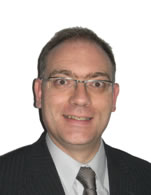 |
Other nuclear projects are also moving in the right direction, as witnessed by developments in Bulgaria and the Fennovoima Project in Finland. In the summer I visited the OL3 construction site with the Swiss Nuclear Society, which really is an amazing place. It is important in terms of positive communications for the nuclear industry as a whole that there are no further delays there. The same is true, of course, for the FL3 construction in France. There was, however, less good news last month with the decision of BKW to shut down the Mühleberg NPP |
in 2019. There had been discussions about making possible new investments in order to prolong its lifetime. But this proposal was ultimately rejected. On the other hand, though, there is now a good deal of pressure being put on the Energiewende (energy transition) plan in Switzerland to deliver enough energy in six years’ time. Personally, I am pretty sure they will fail.
Women in Nuclear (WiN) recently published a book entitled 20 Years of WiN to celebrate its twentieth anniversary. The idea of WiN first saw the light of day during a PIME workshop in 1988. The first ever meeting of “nuclear women”, which was organised by ENS, took place in 1990, in Ascona, Italy. By the end of 1992, WiN was born. Over the last two decades the organisation has grown from infancy, through childhood and its teenage years - when it still needed occasional support from its “mother” - into the strong and mature organisation that it is today. It really has come of age! Congratulations WiN on your twentieth birthday!
Finally, our Society itself has had a successful conference year and is already planning events on the 2014 calendar. These include Pime 2014 and RRFM 2014, in February and March respectively, and both in Ljubljana (Slovenia), as well as ENC2014 in May, in Marseille.
Unfortunately, my term as President of ENS comes to an end in December this year.
I have really enjoyed my time as President and consider it a privilege to have served the Society for the last two years and to have worked closely with so many colleagues. All that remains for me to do now is to say goodbye and to wish ENS all the very best for the future!
Take care.
Marco Streit
President of ENS
http://www.euronuclear.org/e-news/e-news-42/obituary.htm

|
The former Secretary General of the ENS, Dr. Peter Feuz, a giant of the European nuclear community, passed away in hospital in his home town of Bern (Switzerland), on 10 April 2013, after a brave and lengthy battle against debilitating illness. Peter Feuz was Secretary General of the European Nuclear Society for 14 years, from 1982 - 1996. His Central Office, backed up by its small and effective secretariat, worked at the specialist financial company ATAG Treuhand Bern, which later became part of Ernst & Young. Peter held |
leading positions within the company for 37 years before retiring to open an art gallery, thereby transforming his great passion for art into a new professional challenge.
After graduating in political sciences, Peter joined ATAG in 1961, as Chief Editor of the publication of the Swiss Nuclear Association. He was soon appointed Secretary General of the association. He persuaded several Swiss and international energy-related organisations to transfer their secretariats to ATAG – and at the same time he launched ATAG´s PR activities and proved his talent for innovation by, for example, creating quality control departments. After 17 years of hard work Peter turned his attention to developing the international side of ATAG’s business. He was in charge of the Technische Organisationen (technical organisations) unit. His many qualities and talents led to him eventually becoming a partner of ATAG Bern.
During his time as Secretary General of the ENS we got to learn first-hand just how effective Peter was and what a great personality he had. He developed ENS into a leading international organization active in the nuclear field. From the 1980s onwards, he organized, together with Foratom, several European Nuclear Conferences (ENCs). He also developed close contacts between ENS and the American Nuclear Society (ANS). When I served as Chairman of the Information Committee of the ENS, from 1988-1994, we co-operated in a seamless way to develop “tools” for defending nuclear energy against the backdrop of the very negative atmosphere that was generated by the Chernobyl accident. The scope of the Society’s publication Nuclear Europe was extended to become Nuclear Worldscan. We also set up Nucleus, a leaflet that popularised nuclear news. NucNet, the world´s first independent communications network for nuclear energy, was established in 1991.
During Peter’s time as Secretary General of the ENS the annual PIME (Public Information Material Exchange) conference and exhibition was created especially for communications and PR professionals working in the nuclear field. It has developed in to a regular and unique fixture on the nuclear events calendar. Participants from across Europe and beyond, known as ‘Pimers,’ are given a platform for exchanging ideas and views, creating new PR activities, designing new information materials, networking and sharing communications best practices and tools. The fact that PIME is still going strong today, 26 years later, is an eloquent testimony to Peter’s innovative leadership, drive and energy.
Women in Nuclear (Win) was established in 1992 with the aim of creating a worldwide network of women professionals working in the fields of nuclear energy and radiation in order to disseminate fact-based and businesslike information about nuclear energy and radiation. For the past 20 years, WiN has continuously expanded and today counts some 4,500 members in more than 100 countries. Also the concept of the Young Generation Network (young professionals working in the nuclear field), was conceived and launched during his tenure. It is no surprise that the YGN has since greatly expanded into the effective international lobbying network that we know today, promoting nuclear energy among young professionals both nationally and internationally.
After retirement Peter redirected his considerable focus and energy to pursuing his great personal passion - antique sculpture and renaissance art. In 1997, Peter and his wife Ulrike, who had built up an extensive collection of works of art, established their own art gallery, called the Triple Gallery, which is located today in their home, in Bremgarten, Bern. The motto of the art gallery is “Purely Classical – the world of ancient antiquity lives on”. Over a period of 16 years Peter developed the gallery’s business in three distinct areas - antiquities, prehistoric idols and 16th to early 20th Century masterpieces. In order to add new works to the collection he was a regular bidder at auctions in international art houses such as Sotheby´s and Christies in London.
And now, that great organizer and personality who was known personally by so many ENS members, has left us. But Ulrike still keeps their great shared passion, the Triple Gallery, very much alive as a tribute to Peter. On October 10 2013, she organised a preview of the gallery’s current exhibition entitled Weibliche Schönheit und Erotik as a memorial for her late husband. About 70 people participated. I had the honour to be among them and was privileged to be able to talk to those present about Peter´s illustrious international career, especially his many productive years at the helm of ENS; years that helped shape the Society into what it is today.
I am sure that I speak on behalf of many colleagues when I express a shared sense of loss and sadness at the passing of a talented and industrious leader and a great personality. He has left an indelible mark on the history of the European nuclear science community.
Juhani Santaholma (former Chairman of the ENS Information Committee and a close friend of Peter Feuz)
http://www.euronuclear.org/e-news/e-news-42/career-convention.htm


After the great success of its 2012 Career Convention ENS will again organise a similar event in 2014, back-to-back with ENC 2014 in Marseille, France (11 May 2014).
A recent survey among nuclear professionals revealed a very high level of job mobility, with around half of respondents willing to work anywhere in Europe or even worldwide. This is consistent with the ability of many respondents to speak English or French to a good business level, as well as a very high willingness to learn another language if the prospective employment requires it. The preparedness of professionals in the nuclear industry to relocate as well as increase their language proficiency provides an opportunity for organisations that are willing to do so to recruit from the international market.
As the largest European society representing professionals active in the nuclear science and industry community, ENS is well-placed to act as a catalyst for creating this opportunity and to bring together employers and employees in the nuclear sector. Consequently, the 2012 Career Convention attracted highly skilled candidates from over 30 countries who applied while at various different stages of their respective careers – ranging from outright beginners to professionals with more than 10 years of experience. They applied for job opportunities that corresponded to 44 different profiles in areas as diverse as safety and process engineering, procurement management and marketing.
Preparations are now in full swing to repeat this success next year in Marseille. For further information employers interested in hiring highly qualified professionals and employees in the nuclear sector who are actively looking for new challenges can already contact careers@euronuclear.org or call Kirsten Epskamp +32 2 505 30 54.
http://www.euronuclear.org/e-news/e-news-42/hsc.htm


The management and final disposal of irradiated fuel and nuclear waste is often presented by the media and perceived by the public as being an unsolved problem that restricts the future of nuclear energy. However, the nuclear industry focused on this problem very early on and has developed proven technical solutions.
Whereas large volumes of short-lived radioactive waste are already handled by the nuclear industry in surface storage facilities, the management method for high activity, long-lived waste has not yet been decided in detail and is still being studied in all countries that generate nuclear power. Scientific knowledge is continually progressing, technical solutions are emerging, and all within a context in which science and technology interact strongly with social and economic issues. Many technical advances have been made during the last twenty years in fields as varied as partitioning, transmutation, waste conditioning, storage and underground disposal.
Reducing the dangers of waste, decreasing its volume, partitioning the waste into homogeneous categories are principles that are familiar to domestic waste management. They also apply to nuclear waste. Within a closed fuel cycle waste management - from its production to its final destination - looks like a chain of which treatment-recycling, conditioning, storage and disposal of the final waste are the main links. With the open cycle option, the first link is absent.
The first option is, therefore, to close the fuel cycle. This option has a very important influence on the nature of the waste produced, as well as on its subsequent management.
The various options available – the direct storage of spent fuel or the specific conditioning of separated actinides - have been studied worldwide. These options may offer distinct advantages for the nuclear industry in general, but as far as waste management is concerned, the closed fuel cycle is clearly more favourable because it offers the possibility of considerably reducing the radiotoxic inventory, and of putting the waste into a stable and safe form. Recently, the economy of this option has been further reinforced by the increase in the price of natural uranium, which provides a powerful incentive to save on fissile matter.
In the long run, the probable development of fourth generation nuclear power plants will make the closed fuel cycle more widely implemented. With these new plants, one can hope to further reduce the waste toxicity by transmuting actinides. Indeed, the nature of the final nuclear waste (by definition non-recyclable) depends on the nuclear technology being used: final waste in 30 years may well be different from what it is today. For example, it may be possible to further reduce the radio-toxicity of vitrified waste by eliminating some radionuclides (e.g. minor actinides) from the inventory. The exclusion of these radionuclides from the waste would also reduce the exothermicity of the waste, making subsequent waste management simpler. This objective of producing cleaner and cooler waste is the main driving factor behind research into partitioning and transmutation. However, in order to gain a substantial benefit in terms of radio-toxicity, one needs to transmute the separated radionuclides. The technology already exists for recycling plutonium, but research is still needed to make the recycling of other radionuclides viable on an industrial scale.
It is already clear that fission products are not readily transmutable, neither with current nuclear reactors nor with the fast reactors envisaged for the future. Whatever the nuclear system used, fission products will, therefore, remain present in the final nuclear waste. The issue of actinides is less certain since the future of these radionuclides depends on the nuclear reactors available, as well as on the chosen fuel cycle policy. With current reactors plutonium can be recycled under a MOX form, but minor actinides tend to accumulate in the waste. Fast reactors might offer the possibility of transmuting these radionuclides, but this transmutation will remain slow and difficult. Moreover, putting minor actinides in the fresh fuel complicates both fuel fabrication and reactor operation, and it is doubtful whether those responsible for operating the facilities would be very enthusiastic about taking on this burden. The actinides are very insoluble and immobile in geological media and could be stored in an underground repository without compromising its safety. The only important advantage for the transmutation of actinides is the reduction in the waste thermal loading and toxicity, with the associated reduction in the size and cost of the repository.
The two first links in the irradiated fuel management chain, fuel processing and waste conditioning, work well together and are already being implemented in some countries (e.g. France, at the La Hague facility, or Japan at Rokkasho-Mura). Once the waste has been conditioned in canisters one still has to solve the problem of deciding what to do with the latter. Thanks to their chemical and mechanical stability, the present forms of conditioning (concrete, metallic compacted waste, glass) are well adapted for storage and eventually for the underground disposal of long-lived waste. These links in the waste management chain are coherent and this coherence will be maintained with the development of fourth generation fast neutron nuclear systems because future reactors will require a closed fuel cycle with spent fuel treatment processes that will complete rather than replace the existing one.
The industrial processes used for the conditioning of nuclear waste are already mature and operational. Basic research has permitted a good understanding of the physico-chemical mechanisms at play during both the fabrication and the ageing of the conditioning matrixes, glass, concrete or bitumen. The safety study of waste management relies on this scientific knowledge of the long-term behaviour of the confinement matrixes. Suitable conditioning forms have been developed for all types of waste. Solutions of fission products and minor actinides, which possess by far the highest radio-toxicity, are vitrified at industrial scale facilities. The quality of the glass obtained is well proven. For instance, the R7T7 glass developed for the confinement of fission products from the processing of light water spent fuel has become a worldwide benchmark. There are probably more scientific articles written about this glass than on any other industrial glass!
Metallic waste from the spent fuel bundles is compacted and put into steel canisters that are identical to the ones used for glass casting. The radiological impact of this waste form in a geological repository would probably be very small. Technological waste associated with the exploitation of nuclear facilities is conditioned in concrete. Most of this waste is short-lived and of low or medium activity. In many countries, including France, this waste is already stored in dedicated surface or subsurface facilities. A wide spectrum of concrete formulae has been developed to fit the diversity of the waste to be conditioned, solid or liquid. These concrete packages are well characterised and sufficient knowledge of their alteration mechanisms enables their confinement properties to be guaranteed.
Radioactivity possesses two important characteristics that can somewhat mitigate the fear that it provokes: firstly, it is easy to detect, even at very low levels. A unique disintegration can be detected, whereas billions and billions of molecules must be present in order to detect chemicals. Secondly, once detected, it is relatively easy to protect oneself from the radioactivity, by combining shielding, distance, limitation of the exposure time and radioactive decay. Therefore, the solution for storing final nuclear waste all boils down to confining the radionuclides in an isolated and shielded installation for a period of time that is long enough for radioactive decay to take place. This is the idea behind both storage and underground disposal facilities.
Whatever the fate envisaged for irradiated fuel it must first be stored temporarily. Countries that have chosen the open fuel cycle option must store the spent fuel before its disposal; the ones which have opted for the closed fuel cycle option must store it for a few years, in order to let it cool before it is processed. The vitrified final waste is then stored temporarily. In all cases, storage is a temporary solution which provides flexibility for the management of waste, because it allows the waste to cool down - which in turn decreases its thermal load - before its final storage at the disposal facility. This ultimately reduces the cost of the installation. However, the safety and security of storage facilities is less well assured than that of an underground disposal facility, because the former demand active maintenance and are more vulnerable to human intrusions than the latter. Even if economic arguments plead in favour of long-term interim storage, public policy would be well advised to limit the duration of this storage to a reasonable maximum, for example the time for which maintenance of the installation can reasonably be guaranteed.
Last but not least, one has to find a final place for the final waste. The deep geological underground disposal option seems to be the only long-term solution that does not require continuous societal control. General consensus has been reached on this issue, under the aegis of the International Agency for Atomic Energy (IAEA) and of the Nuclear Energy Agency of OECD: no better solution has been identified. Disposal in a geological repository will always be an expensive operation, hence the need for reducing the volume and the thermal power of the waste as much as possible. These two parameters largely determine the repository capacity, and therefore, its duration of exploitation and its cost. The processing of spent fuel is already a major step towards achieving the aforementioned reductions since it involves the removal of the uranium (which represents 90 % of the mass of the spent fuel) and the removal of the plutonium (which represents the major contribution to the total radio-toxicity of the waste). The American Advanced Fuel Cycle Initiative (AFCI) is exemplary in this respect. After more than 20 years of effort, which led to the launch Yucca Mountain repository spent fuel disposal project, the US Department of Energy is reconsidering the optimisation of its use and the nature of the objects that will be disposed of there.
The safety of the underground disposal relies on its capacity to confine radionuclides within an underground facility, until radioactive decay has brought their radio-toxicity down to an acceptable level (usually a level equivalent to that of a natural uranium deposit). The safety demonstration of such an installation will rely in fine on confidence that the installation will behave as foreseen. Studies have, therefore, been carried out to better understand the evolution of waste packages in an underground environment and the migration of radionuclides through the man-made and geological barriers that isolate them from the biosphere. Removing from the waste the long-lived radionuclides that contribute most to its long-term radio-toxicity could significantly shorten the time that the waste will remain dangerous. This could also reduce the scientific uncertainties associated with very long timescales. This option will only be available if and when one is able to separate and transmute minor actinides.
The concept of underground disposal is flexible. Initially designed with the idea of definitively and irreversibly getting rid of the waste, the underground disposal concept has evolved in all nuclear countries towards the concept of reversibility (which means being able to retrieve the waste from the repository after some time). That approach seems to have become a prerequisite for public acceptance of these installations. It contributes to modifying the image of underground repositories without overly changing their general conception.
Thanks to the efficiency and the redundancy of its barriers, underground disposal is also a robust concept. The radiological impact of deep geological waste disposal that evolves normally should remain very small, local and delayed. However, altered evolutionary scenarios within the repository, which are by definition unpredictable (especially those associated with human intrusions), can have a larger impact.
Strictly speaking, the safety of a deep geological repository cannot be demonstrated, because the very long timescales make direct experiments inaccessible. Therefore, the objective must be more modest: to show by means of partial experiments that the main physical and chemical phenomena at play are understood and mastered and, therefore, to validate the main elements of the modelling of the repository’s long-term evolution. The study of natural and archaeological analogues contribute to this process of confidence building, showing that in sites like Oklo radionuclides have been confined over extremely long durations.
All national and international studies show that the impact of a repository on man and on the environment will remain negligible, even in the very long-term. In order to convince people of that fact, it will be necessary to build confidence with converging indications that show that all the possible events that are liable to affect the repository have been envisaged and are found to be within acceptable limits… in short, that the repository concept is a well mastered one. This confidence already exists among most specialists, but is not shared by the public. Furthermore, as long as citizens have their doubts politicians will tend to postpone taking decisions. The example of Finland and Sweden, two countries which decided democratically to build geological repositories for nuclear waste, shows that it is possible to overcome this obstacle.
We inherited nuclear waste from our predecessors and we produce waste ourselves. We cannot pass on this burden to our children, that is why we must put all our efforts into minimizing final waste and managing it in accordance with the best possible safety conditions and by exploiting the best technologies available today (this is why the concept of ‘retrievability’ is so important). The technologies exist. Their implementation requires that a political decision be taken. Contrary to widespread public opinion, much progress has been made in the design of technically and socially acceptable nuclear waste repositories. Most of the experts agree on this, but the public and politicians are still reluctant to act and must be persuaded by an irreproachable process of confidence-building. One thing appears very clear to the authors: it would be an irresponsible attitude to store this waste for a long time, while waiting for a hypothetical scientific advance to occur. Science also has its limits!
As has been shown, even if one considers only the scientific and technical aspects, waste management is a multidisciplinary challenge: knowledge of reactor physics is needed because the nature of the waste produced depends on the reactors used. Advanced chemistry is necessary to determine which radionuclides are left in the waste after the fuel has been processed. Mastery of physico-chemistry and material science is essential for understanding waste conditioning and the long-term behaviour of waste. Knowledge of engineering is a prerequisite for appreciating the thermal phenomena that are at play inside the storage installations. Expertise in mining engineering is vital when designing an underground repository - as is that relating to earth sciences like geo-chemistry to understanding and predicting the long-term evolution of these installations. Finally, a high level of competence in radioprotection is an absolute must in order to evaluate accurately the impact of all these processes and installations on man and the environment.
Nuclear energy will continue developing worldwide, in spite of the Fukushima accident. Even in those European countries that have decided to phase-out nuclear energy there is a legacy of nuclear waste that must be dealt with. The scientific and technical expertise needed for waste management already exists. Management decisions must be taken. Now is the time for political courage.
1 Prepared by Bernard Bonin
http://www.euronuclear.org/e-news/e-news-42/NESTet2013.htm


From 17 – 20 November 2013, over 120 people congregated at the Universidad Politecnica de Madrid, in the Spanish capital city, to take part in the ENS flagship conference NESTet 2013. NESTet conferences are dedicated to discussing all things related to education and training (E&T) in the nuclear sector. Among the participants, who came from many countries both in Europe and further afield (e.g. Japan, Australia, the US, South Africa, Singapore and Canada), were members of national nuclear societies and of ENS, educationalists and trainers, academics, researchers, officials from the European Commission, industry representatives, consultants and even a management psychologist. Jean-Pol Poncelet, Secretary General of ENS, gave the opening address before handing over to G Jimenez of the Spanish Young Generation, who gave an overview of the host country’s experience in the field of nuclear E&T.
The conference programme centred upon a number of plenary sessions and parallel workshops. Each one was followed by a questions and answers session and debate, which often spilled over into the coffee breaks and lunch breaks. Among the key issues discussed were: maintaining nuclear knowledge and competence within the EU; ensuring that nuclear education and training can stimulate young professionals to pursue a career in nuclear; the very latest academic programmes, training courses and educational tools; redressing the deficiencies in E&T provision; the problems, challenges and approaches specific to certain countries (both in Europe and abroad), training the trainers; the harmonisation of E&T needs across Europe; the interaction between nuclear E&T and civil society and E&T needs for new build.
On the final day of the conference participants were able to choose from two technical visits - one to the facilities of Tecnatom, a Spanish company specialising in nuclear technologies and services, and the other to the Zorita (Jose Cabrera) NPP.
In the next edition of ENS NEWS, N° 43, more detailed reports on NESTet will be provided. So, don’t forget to read more about this important international ENS conference.
Editor-in-Chief
http://www.euronuclear.org/e-news/e-news-42/PIME2014.htm


Every year, during the PIME (Public Materials Information Exchange) conference, a flagship event organised by the European Nuclear Society (ENS), the PIME Award for Communications Excellence is presented to the creator of what is judged to be the most effective, results-oriented communications campaign launched recently in the nuclear sector.
There is no shortage of awards being presented every day; some might say too many. But there is only one stand-out award that recognises excellence when it comes to communicating on the sensitive and specialised area that is nuclear energy - the PIME Award for Communications Excellence.
So, what is it that makes this award stand out from the crowd? What is its special added value? The answer is peer review. From a professional perspective there is nothing more satisfying than getting the recognition and praise of your fellow communicators, or knowing that your efforts have perhaps inspired them to find solutions to meet their communications challenges. It’s also about sharing with others.
A jury of nuclear communications professionals assesses all the entries and a shortlist of the best ones is drawn up. These shortlisted campaigns are then presented, showcased and “sold” to PIME delegates during the conference. The delegates, your fellow communications professionals, then cast their votes and the winner is determined. The award is presented at the end of the conference.
If you have achieved success with a recent communications campaign don’t keep it to yourself. Share it with others and send it to ENS. If it is shortlisted it will be centre stage during the 2014 PIME Conference, which is taking place in Ljubljana, Slovenia, from 16 – 19 February 2014.
If you know of another communications campaign that is worthy of being entered for the award, but perhaps its creator is too modest, please let us know and it can be assessed too along with all the other cmapigns.
You could soon be the proud winner of the 2014 PIME Award for Communications Excellence. It can also provide your organisation with the oxygen of publicity and inspire your fellow communicators around the world to achieve similar success!
Send in your campaign entry NOW and take part in the 2014 PIME Award for Communications Excellence.
MARK YOUR DIARY – Join us in Ljubljana from 16 – 19 February 2014
PIME 2014 Conference Secretariat
organised in collaboration with:
http://www.euronuclear.org/e-news/e-news-42/RRFM2014.htm


In 2014 the European Research Reactor Conference, RRFM, will take place from 30 March - 3 April 2014 in Ljubljana, Slovenia.
The RRFM 2014 Programme Committee is now calling for both oral and poster presentations regarding
All Key Areas of the Nuclear Fuel Cycle of Research Reactors
Utilisation of Research Reactors
Innovative methods in reactor physics and thermo-hydraulics
New Research Reactor Projects
Research Reactor Operation and Maintenance
Safety and Security of RR
Mark your diaries and be a part of it! Upload your abstracts on www.rrfm2014.org before 15 November 2013.
Authors should submit their abstract text in English through the Abstract Submission System on Reference number ISBN 978-92-95064-20-1 |
http://www.euronuclear.org/e-news/e-news-42/ENC2014.htm


11 - 14 May 2014, Marseille, France
Call for Papers – Deadline extended to 22 November 2013!
ENC 2014 provides a platform for the nuclear science community to share their experience and to learn about the latest developments going on in nuclear research and their practical applications. It will furthermore exploit synergy among scientists, industry representatives, policy-makers and citizens on wider societal issues that impact upon how the nuclear science community carries out its work.
ENS and the ENC 2014 Programme Committee are now calling for abstracts in the following areas:
Plant operations and safety
Education, training and knowledge management
The fuel cycle
Reactor technologies
New Build
End of Use management
Life science applications
Non-power applications
Nuclear in the civil society
For examples of relevant topics for each of the mentioned subject please go to the ENC 2014 website.
Join us at ENC 2014! Send your abstract now!
Upload your abstracts before 22 November 2013 |
![]() Click here to download the ENC 2014 Call for Papers
Click here to download the ENC 2014 Call for Papers
Authors can either submit a Full Paper or an Extended Abstract. Full Papers will be peer reviewed under the auspices of the ENC 2014 Programme Committee and the ENS High Scientific Council. Extended Abstracts will not be subject to a peer review process.
Important dates
Deadline for abstract submission: 31 October 2013
Notification of authors: 15 December 2013
Deadline for submission of Full Papers requesting a peer review: 15 February 2014
Revision of Full Papers concluded and author notification: 15 March 2014
Deadline for submission of Full Papers and Extended Abstracts: 15 April 2014
Deadline for submission of CV and PowerPoint presentations: 28 April 2014
Conference: 11 - 15 May 2014
Accepted and presented Full Papers will be included in the Conference Proceedings (Transactions) that will be published with reference number ISBN 978-92-95064-21-8 on the website of the European Nuclear Society and on www.enc2014.org.
ENC 2014 Conference Secretariat
http://www.euronuclear.org/e-news/e-news-42/sne-news.htm

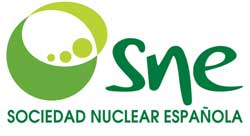
The 39th Annual Meeting of the Spanish Nuclear Society (SNE) was held in Reus from 25 to 27 September 2013 (www.reunionanualsne.es). The meeting was supported by 23 sponsors, and 27 companies participated in the parallel exhibition. A total of 640 people from all areas of the nuclear industry, together with 61 accompanying guests, attended the event.
The Annual Meeting has established itself as a forum for professionals in the nuclear sector to exchange knowledge, experience and research expertise in all areas related to nuclear energy. It also facilitates the discussion of current developments taking place in the sector.
Among the key outcomes reached by the industry professionals present was the consensus about the conjunction between technological development, investment, transfer of knowledge to the young generation and security gains, all of which could extend the operation of Spanish nuclear power plants for up to at least 60 years.
The attendance figures show the level of interest that was aroused by the event. Altogether 35 technical sessions were organised, during which experts in each respective field presented 342 papers featuring the latest developments in nuclear safety, radiation protection, fuel, radioactive waste, human resources organization, operation, maintenance, engineering, R & D, new reactors, fusion, dismantling and communications.
In the three plenary sessions it became clear that training is considered to be a strategic pillar for the safe operation of the plants and for ensuring a successful future for the Spanish nuclear industry. From college days to daily experience at the workplace, thorough and focused training is the key to ensuring long-term operation and the reliable and efficient functioning of the nuclear fleet.
Another topic discussed was the internationalization of the Spanish nuclear industry, which within today’s economic and political environment is all about helping to identify and exploit global opportunities that can make good use of the accumulated experience of highly qualified professionals and high-performing companies.
The third plenary session, which addressed the subject of Management and prioritization of regulatory requirements, was in the form of a roundtable.
In addition, two monographic sessions were held on such interesting topics as Research in the nuclear sector and Electric power interconnections and security of supply.
Two courses were also given that aimed at exchanging information and knowledge about topics such as The electricity market and the domestic bill and Human error prevention techniques in engineering works.
The Young Generation Nuclear, in coordination with the University Rovira i Virgili, in Tarragona, gave a presentation about basic nuclear science and technology that was attended by 170 students.
Women in Nuclear (WiN) organized an interesting seminar at the Chamber of Commerce of Reus entitled What's behind the electric bill? It enabled participants to learn more about the various elements that make up consumers’ electricity bills.
The technical programme was complemented by a cultural and social programme that centred around the beautiful city of Reus.
During the official dinner SNE presented a number of awards. The fortieth Annual Meeting will be held in autumn 2014 in the city of Valencia, and will be hosted by Iberdrola.

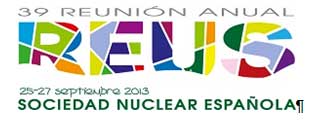
On 20 July 2013, the SNE Technical Seminar 2013 took place in Madrid. As in recent years, it was organized by the Technical Commission of SNE. It was a great success, with approximately 60 people in attendance. The topic of the seminar was Fire Protection Programmes: the CSN Safety Instruction IS-30, Revision 1. The opening session was chaired by Francisco Lopez, President of the SNE; Yolanda Moratilla, from the Universidad Pontifica de Comillas; José A. Carretero, from Empresarios Agrupados (who acted as Session Coordinator) and Juan Bros, President of the Technical Commission of SNE. It stressed the timeliness and relevance of the theme chosen for the seminar, as well as the high level of presentations and speakers that accurately reflected the considerable interest shown in the topic.
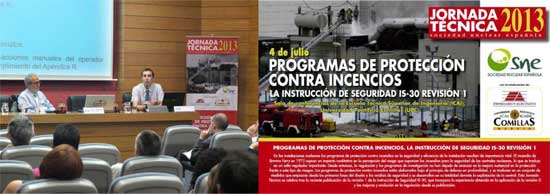
The SNE has awarded 9 scholarships from among the 25 applications that were received as a result of the 2013 call for post-graduate scholarships in nuclear expertise.
The SNE also awarded the prize for the best SNE 2013 Thesis, Master's Thesis or Dissertation and the prize for the 6th AREVA Photography Competition.
http://www.euronuclear.org/e-news/e-news-42/susen.htm

The NRI Group, which is a member of the Czech Nuclear Society, is currently carrying out the largest nuclear research investment project in the Czech Republic. It represents a significant milestone for nuclear R&D in the Czech Republic, a country with almost 60 years of nuclear history. The Czech Nuclear Society (CNS) would like to present you here its Nuclear Fuel Cycle research programme, which is directed by Mr. Kovarik, a member of the CNS board.
The SUSEN (Sustainable Energy) Project is being carried out at two regional R&D centres. The total budget of the project is approximately €95 million. It focuses mainly on extending the life cycle of existing R&D facilities and on the development of new technologies for supporting current reactors and future GENIV reactors. SUSEN is divided into 4 research programmes: Technological Experimental Circuits (TEO), Structural and System Diagnostics (SSD), Nuclear Fuel Cycle (JPC) and Material Research (MAT). The project is being undertaken at two regional centres - in Pislen (at the West Bohemia University) and the headquarters of the Rez Research Centre.
The Nuclear fuel cycle (JPC) research programme focuses on R&D related in particular to the back end of the nuclear fuel cycle, more specifically low and intermediate level waste (RAW) management, deep geological disposal and the reprocessing of spent nuclear fuel. In the following report the main technologies that are developed under the SUSEN Project on the Nuclear Fuel Cycle are outlined. More information about the project can be found at: www.susen2020.cz.
The FERDA2 (Fluoride Research and Experimental Development Assembly) technology line is a research facility which will be used for carrying out the separation of radionuclides from irradiated uranium oxide using the fluoride volatility method. FERDA2 will be situated in the hot cells. It is designed to perform experiments with irradiated uranium powder. It is a prototype device for demonstrating the fluoride volatility method for different spent fuels from currently operating and/or GENIV reactors. To some extent, the FERDA2 technology line follows on from the RENATA, FREGATE-2 and FERDA 1 research lines, which were designed and put in operation at UJV Rez in cooperation with the former Soviet Union between 1975 and 1987. The basic design of FERDA 2 has been finalised and the technological line has moved on to the manufacturing and building phase. The deadline for completion of construction, commissioning and final handover is December 2015.
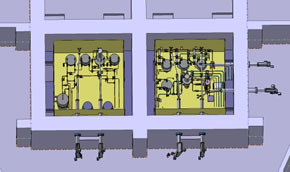
Fig. 1 - FERDA2 technology line - view inside the hot cells
The objective of this device is to study the behaviour of molten fluoride salts, methods of preparing and handling molten salts in various operating modes, performing long-term corrosion tests and tests of various types of seals in flanged joints. The construction of the loop should allow the simple replacement of tested parts within a modular system framework. The device should also serve to verify the measurement systems, to develop measuring sensors and measuring technology for molten salt reactors, to study the dynamics of systems with molted salts and to study issues related to their stability and safety. Last but not least, the loop demonstrates the transferal of thermal energy flow.
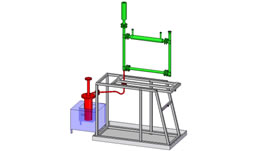
Fig. 2 – Experimental loop for working with molten salt
The MSO (molten salts oxidation) technology line is an experimental semi-pilot plant used for carrying out the non-flame oxidation of solid and liquid low-level and medium-level toxic wastes in molten salts. The research objective here is to assess the real operational applicability of molten salts for the effective destruction of the above-mentioned types of waste, both in terms of environmental technology and economic suitability. The MSO technology line will be a modular system and, according to needs, will allow for the extension or replacement of some of the technology and support systems (eg, measurement and control). Currently, the tendering procedure for the supply of this device is open and the deadline for completion of construction, commissioning and final handover is December 2015.
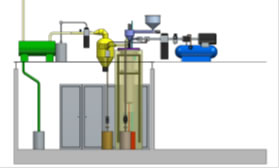
Fig.3 –MSO technology line
This device is a modular system simulating certain methods used for processing liquid radioactive waste and secondary waste at nuclear power plants (evaporation, in-drum drying, bituminization). The purpose of the device is to optimize this process, to study other processes that might lead to the minimization of liquid and semi-liquid radioactive waste, to develop new matrices for the solidification of concentrates, to develop methods for the fixing of saturated and non-saturated ion exchangers, etc. The device will also be used for developing prototype modules and various design elements that will be suitable for innovating existing facilities, thereby increasing their performance and efficiency, reducing energy consumption and extending their service life. At present, the tendering procedure for the supply of this device is open and the deadline for completion of construction, commissioning and final handover is July 2015.

Fig.3 – Technology line for the disposal of liquid radioactive and hazardous waste
An induction furnace with a cold crucible is an instrument that is used for the high-frequency induction melting of materials and the investigation of high-temperature melts. The main advantages of this method are the non-pollution of the melt material and the possibility of reaching and maintaining the melt at a high temperature (more than 3000°C). The device will be used for materials research (phase diagrams) and especialy for research into the high temperature synthesis of functional materials, for the simulation and monitoring of physico-chemical properties of oxide mixture melts based on CORIUM and for the modelling of severe accidents in nuclear power reactors. Last but not least, this device will be used for vitrifying radioactive waste. At the moment, the tendering procedure for the supply of this device is open and the deadline for completion of construction, commissioning and final handover is December 2014.
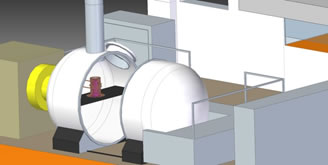
Fig.3 – Technology line for the disposal of liquid radioactive and hazardous waste
The laboratory will house two induction systems equipped with a cold crucible. The first installation will have an generation output of up to 160kW and the second one will have an generation output of up to 300kW.
Jana Dymáčková and Petr Kovařík,
Rez Research Centre, plc.
http://www.euronuclear.org/e-news/e-news-42/croatia.htm

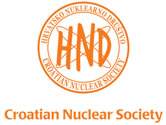
The Croatian Nuclear Society (HND), in cooperation with the International Atomic Energy Agency (IAEA), the European Nuclear Society (ENS), and the Croatian State Office for Radiological and Nuclear Safety (DZRNS), will organise the tenth edition of the international conference entitled: Nuclear Option in Countries with Small and Medium Electricity Grids. The Conference will be held at Hotel Kolovare, in Zadar, Croatia, from 1-4 June 2014.
The conference will focus on the nuclear option from the point of view of national energy strategy; resources; costs; technological, organisational and educational requirements and environmental advantages. It will also analyse matters relating to operational safety, fuel cycle, waste management, nuclear liability and decommissioning.
The main objective of the event is to promote regional co-operation and exchange of experiences in the use of nuclear power and fuel cycle facilities among small or medium-sized countries with an interest in the nuclear option.
For further information about the conference, please refer to the attached file First Announcement and Call for Papers or visit: www.nuclear-option.org
Dubravko Pevec
Secretary General
Croatian Nuclear Society
http://www.euronuclear.org/e-news/e-news-42/snus.htm

The Pohoda Summer Music Festival has been transformed over the years from the one-day event it was back on 1997 to what is now the most attended 3-day multi-cultural open-air event currently organised in Slovakia. Slovak Nuclear Society (SNUS) again participated at the festival with the aim of presenting the many peaceful applications of nuclear energy in medicine, education, science, industry.
The SNUS Info-kiosk was located in the NGO section at the centre of the festival’s activities, close to the main stage. The location helped increase visitors’ interest in the Info-kiosk, especially in the competitions that had been prepared for visitors. For the first competition visitors-competitors measured the shielding capacity of their bodies against ionizing radiation. The one with the shielding capacity closest to the benchmark (which was the shielding capacity of the SNUS Young Generation chairman) won a mountain bike. The lucky Winner, Matej Povazan, went home on his new bike!
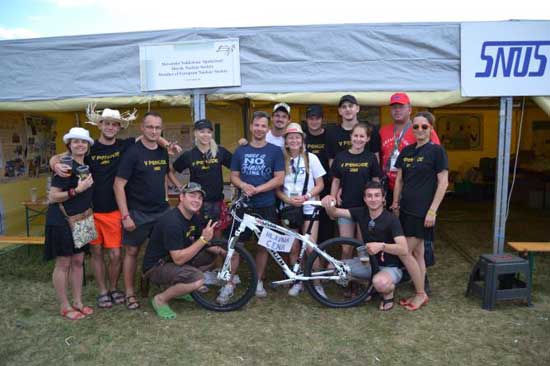
The second competition – a Quiz on Nuclear Energy - was more difficult and required some knowledge to answer all the questions. Most competitors did not have sufficient knowledge and had to look for it at the Info-kiosk, in posters or in discussions with SNUS YG members. Three participants with the most correct answers to the quiz won mini-tablets that were provided by the nuclear power plant operator - Slovenske Elektrarne. It was funny to see competitors running from one poster to another and to listen to their discussions about ‘what for heaven’s sake is a ‘Becquerel’.
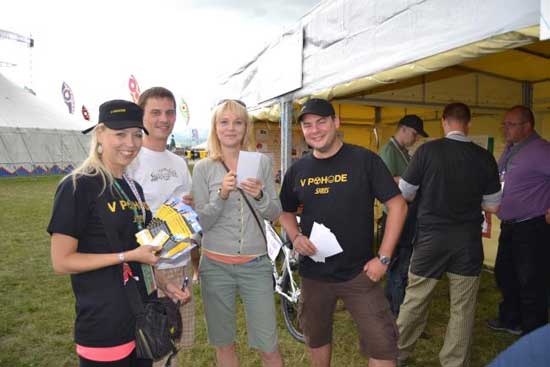
Another attraction was a charging table for mobile phones. Its capacity was used at 100 % and sometimes there desperate pleas for a “little bit of energy”. Obviously, many people came to have a look out of curiosity, to get information or answers to unanswered questions, which YG members gladly tried to provide. The main topics discussed were Radon (a gas that is released from the ground or building materials and which has to be removed from buildings by venting), radiation and the safety of nuclear installations.
The most interesting moment for me was when a 15 years old boy, even before the info-kiosk was officially opened, kept the organizers on their toes with clever and precise questions. He gave some young professionals a tough time and they had their work cut out to satisfy his curiosity. The interest of festival attendees in nuclear power and nuclear energy was extraordinary, and I was not the only one who was surprised. We even had foreign visitors, a young couple from Russia. We are already looking forward to next year’s festival, once again with SNUS Young Generation heavily involved!
Richard Borbély
SNUS Young Generation
http://www.euronuclear.org/e-news/e-news-42/bulgaria-yg.htm

|
|
|
A survey was recently conducted by the Bulgarian Nuclear Society’s (BgNS) Young Generation Network into the role of and expectations of the Bulgarian Nuclear Society. The fieldwork carried out lasted almost 2 months. The data obtained were analysed and a summary report was written outlining the main findings and conclusions. It was presented during the Annual Conference of the BgNS – Nuclear Power for the People - which took place from 18 - 21 September 2013.
A questionnaire was designed and distributed to BgNS members in order to learn about how they interact within and shape the Society, to study the influence that the Society has on the general public’s attitudes and behaviour, and to determine measures for improving BgNS activities.
Based on the feedback obtained the following findings were summarized:
Most of the respondents learnt about the BgNS from friends.
Most YGN members have been participating in the initiative for a year.
Most of the respondents participate in conferences/ workshops and would like to participate also in training activities, public discussions and career development initiative.s
The majority of respondents consider that the Society’s activities should be aimed at influencing the political elite, at raising the awareness of the public in large on all things related to the nuclear energy, at responding effectively to the manipulation of the media, at developing a nuclear forum, at using interactive tools, etc.
Only three people took part in ENS activities.

After analysing the findings of the survey and discussing the proposals, we came to the following conclusions:
The arrangement of meetings with high school students, university students and academia is necessary to raise their awareness of the safe use of nuclear energy and should continue.
More proactive young people should be attracted to take part.
Expanding the use of interactive tools and social media to reach the general public must be encouraged.
Efforts should be made to influence the political class and to participate in the decision-making processes by providing expert statements and participating in commissions.
BgNS activities should be further promoted using PR initiatives and by promoting the Society’s visibility in the mass media.
The participation of young specialists in ENS activities should be fostered.
The BgNS Young Generation Network
http://www.euronuclear.org/e-news/e-news-42/france-yg.htm

The SFENJG (French Nuclear Society Young Generation) has been working actively to establish a strong and dynamic network. SFENJG’s mission is to share knowledge amongst young nuclear professionals by giving presentations in universities, by organising interviews and visits and by participating in conferences. Another objective is to share experiences and knowledge at a European and international level with our colleagues, thereby remaining open to new possibilities and developing our networking capability. The network is also willing to make the French nuclear industry in general more accessible to our international counterparts.
Amongst the most recent interviews that we have carried out is one with Dominique Minière, EDF’s Senior Vice President, Deputy Chief Operating Officer, and the President of SFEN. Another was with Thibault Labalette, Programme Director at ANDRA. Both interviews were in French. Our desire to share knowledge and experience internationally, however, also led us to conduct some of our interviews in English, for example the one with François Gauché of the CEA, who spoke about the Sodium Fast Reactor ASTRID (see below).
Making French nuclear facilities more accessible to our counterparts is also a major international objective. Our Belgian and Dutch colleagues were able, therefore, to visit the La Hague and Flamanville sites in October 2013. They were also able to share a convivial dinner with young professionals and SFEN active members.
Over the last months a great deal of effort has been put in by SFENJG for the organisation of our annual event Atoms for the Future on Nuclear Energy and Power Grid, opening the debate to the different energy sources and discussing a range of grid related issues (flexibility need, volatility of Renewables, black-out situations, load-follow and impact on reactor design and emergency operation, etc.). What better introduction could there have been to this conference, which was attended by 250 international participants, than a motivating speech from Dominique Minière, who shared the good news on the Hinkley Point project in the UK? His introductory speech set the tone for this conference, highlighting the challenges that have yet to be faced and the objectives to be achieved if nuclear energy is to reach out to young professionals.
After two days of discussions driven by high-ranking speakers (Christophe Béhar, CEA Director of Nuclear Energy Division; Philippe Knoche, AREVA Chief Operating Officer and Member of the Executive Board; Michael Fuchs, E.ON Head of Technology; Ron Cameron, Head of OECD/NA Nuclear Development Division; Hadid Subki, IAEA Technical Lead for SMR Technology Development; etc.), the 55 participants also had an opportunity to visit EDF’s Les Renardières research centre, as well as the RTE Dispatching Centre and the Dampierre NPP. The great success of this conference was a great source of motivation and a positive step forwards for the organisation of the European ENYGF2015 conference.
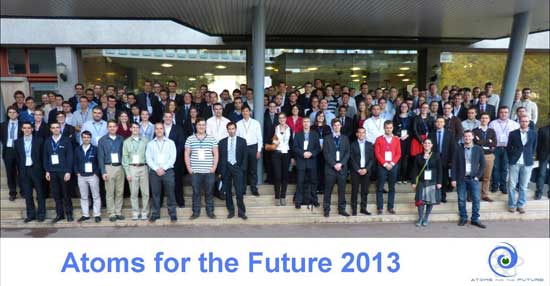
In order to maintain and share the strong motivation that it has to help its colleagues around the world SFENJG is pleased to announce that the topic of the Atoms for the Future 2014 conference will be Design, construction and licensing of Nuclear Power Plants. We will come back to you soon regarding this event, hoping that many of you will attend this open and truly international conference!
http://www.euronuclear.org/e-news/e-news-42/sfen-interview.htm

Mr GAUCHÉ is the Manager of the Generation IV Reactors Programme at the Nuclear Energy Division of CEA, (the Alternative Energies and Atomic Energy Commission, in France). SFEN YG interviewed him on the ASTRID project (Advanced Sodium Technological Reactor for Industrial Demonstration). Here is a transcript of that interview.
The ASTRID Project consists of the R&D, design and development of a 4th Generation Sodium Fast Reactor Prototype, with a level of safety that will be at least equivalent to the third generation of LWR and will integrate into its design the lessons learnt from the Fukushima accident.
The project involves several companies active within the nuclear industry:
CEA, the contracting owner, is in charge of core design
AREVA is in charge of the Nuclear Steam Supply System, Instrumentation and Control Systems and Nuclear Auxiliaries
EDF provides support and experience for the contracting owner and performs safety studies
Alstom Power Systems brings its worldwide expertise to bear for the design of the energy conversion part of the plant
Other companies are involved in various parts of the design (TOSHIBA, COMEX Nucléaire, ASTRIUM, Rolls-Royce, JACOBS France)
The most widely used reactor technology uses water as a coolant, whereas sodium fast reactors (SFRs) are cooled by liquid sodium. Water slows down neutrons, whereas liquid sodium does not. That is why nuclear reactions in SFRs are governed by high speed neutrons, hence the name fast neutron reactors (FNRs). However, nuclear reactions in water-cooled reactors are, on the contrary, governed by low speed neutrons (‘thermal’ neutrons). In nuclear reactors, fissile nuclei can be split by neutron absorption into ‘fission products’, releasing at the same time both energy (used for electricity generation) and neutrons. These neutrons can either produce new fission (chain reaction), or be captured by nuclei, or leak out of the reactor.
It is a remarkable fact that, although the majority of the natural uranium – which is made of Uranium 238 – is not fissile, it can be transformed into fissile Plutonium-239 by the capture of a neutron: this is called conversion. In a thermal neutron reactor, the ratio between conversions and fission is always less than 1, thus the quantity of fissile material decreases in the reactor during the course of the cycle. In an FNR it is possible to obtain a balance between conversion and fission (‘iso-breeding mode’) or even have more conversion than fission (‘breeding mode’). Using that possibility, the spent fuel unloaded from an FNR can contain as much fissile material as when it started. Of course, uranium-238 is consumed in the process.
There are limitations due to the fission products (that hinder the chain reaction) and to the dose level that can be supported by materials like the fuel cladding. These limitations determine the duration of the cycle, at the end of which it is required to unload the fuel, recycle the uranium and plutonium while removing the waste products, and reload new fresh fuel.
ASTRID will operate in iso-breeding mode so as to stabilize the quantity of plutonium in its fuel cycle.
FNRs can also burn so-called minor actinides, i.e. isotopes that were produced in a reactor by neutron capture of plutonium (neptunium, americium and curium). ASTRID will provide demonstration capabilities for such a process, which is also called transmutation.
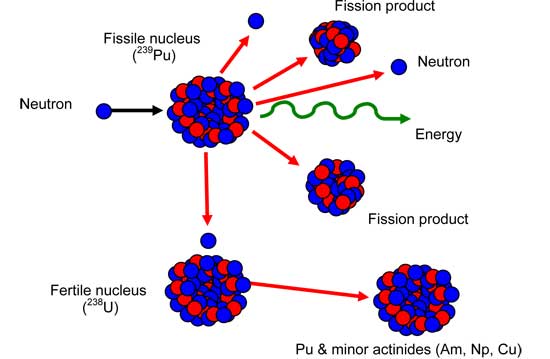
Basics of Uranium-Plutonium chain reaction within SFRs
Many SFRs have already been built and operated. The most powerful SFR ever built was the French ‘Superphenix’ reactor. It was able to deliver up to 1200 MW of power to the electricity grid and was operated for 12 years. The total accumulation of the years of SFR operating experience using this technology amounts to approximately 400. Today, several SFRs are still operating, in Japan1, Russia, India and China.
Liquid sodium is harder to handle than water. Indeed, hot liquid sodium inflames in contact with air and reacts chemically when in contact with water. Not really attractive at first sight, right?
The choice of such a coolant for an FNR is based on several criteria. The first one is not to slow down neutrons. That is why water is excluded. But other key parameters (such as thermal properties, viscosity, compatibility with steel, etc.) are of the utmost importance as well. There are other possible coolants that can enable the fast-neutron reactions to take place. However, following an analysis of the advantages and drawbacks involved, and taking into account safety and operability considerations, it is difficult to find a good replacement for sodium. For example, liquid lead could be considered as a coolant instead of sodium, but one of its major disadvantages is its narrow range of operation: indeed, at temperatures above 480°C lead becomes highly corrosive for the steel that the reactor vessel, circuits and fuel cladding are made of. On the other hand, the reactor must not be cooled to less than 400°C to ensure that lead does not freeze in the circuit. So the compulsory temperature range of the reactor at all times would be between 400 and 480°C, which is not that comfortable, e.g. for maintenance in a “cold” state. In order to widen that 80°C range, bismuth can be combined with lead to lower its freezing temperature. Unfortunately, when subjected to radiation bismuth is transmuted into Polonium-210, which is a highly radiotoxic isotope.
Alternatively, instead of liquid sodium, a gas might be used, like helium. However, gases have a low thermal inertia, which means that these types of reactors are sensitive to depressurization. Safety demands that high margins be taken and that materials that can withstand up to 1600°C be used: this technology is not available today and will need significant R&D before proof of its feasibility can be obtained.
These two examples show that there is no such thing as the “perfect” coolant. The weaknesses of sodium are well-known and engineered barriers can be designed to control them, so that as a result of a multi-criteria analysis, sodium is considered worldwide as the reference choice for FNRs.
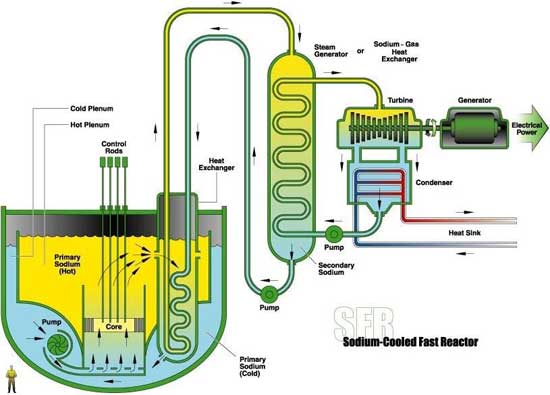
Circuits in a Sodium Fast Reactor
There are three main issues to deal with here: air-sodium fires, sodium-water reactions and a more technical issue known as “positive void-coefficient”. In order to avoid sodium fires resulting from its coming into contact with air, on top of design provisions and quality control of the piping, the rooms where sodium circuits are located can be filled with nitrogen instead of air. Moreover, the vessel is made of three layers: the main steel vessel is contained in a safety steel vessel, which is in turn contained in a concrete vessel-shaped pit with a steel-liner. The “pool-type” reactor design benefits from a fully integrated primary circuit, i.e. all the equipment is contained in the vessel, instead of drawing pipes out of the three-layer vessel. That makes the reactor mechanically stronger and provides the guarantee that the sodium cannot physically escape from the primary circuit.
In classical designs where steam generators feed steam to a conventional turbine connected to an electrical generator, sodium-water reactions can occur and need to be addressed. To make sure the consequences of such a sodium-water reaction do not affect the primary circuit, one possibility is to limit the size of the steam generators (modular steam generators). They are installed on a so-called ‘intermediate circuit’, which is a second sodium circuit used to provide an additional barrier between the primary circuit and the environment, so that the water-sodium interface, located in the steam generator between the intermediate circuit and the water circuit, is far away from the nuclear material. Another more radical solution currently being studied is to replace the water with a different liquid - pure nitrogen for instance. There is also one more drawback to using sodium: contrary to most water-cooled reactors, SFRs’ void-coefficient is positive in classical designs, which means that in case of the coolant boiling the core reactivity increases and leads to a power excursion. To avoid that, the shape of the core for ASTRID has been designed to get a very low or negative void-coefficient and thus to avoid the power excursion in case of a loss of cooling accident: this is a major safety improvement compared to previously designed SFRs.
‘Pool-type’ SFRs have a thermal inertia combined with a boiling margin around 20 times greater than that for water-cooled reactors. That is of great help in accident studies: in the case of a loss of reactor cooling, the low kinetics of the accident increases the ‘grace period’ required to take the necessary actions to bring the plant back to a safe state and to avoid severe accidents such as reactor core meltdowns.
Another good point is that the operating temperature of SFRs is around 550°C, which allows considerable heat exchanges with air. Thus, the heat sink, usually a sea or a river, can be diversified: in case of loss of the main heat sink, dedicated safety systems transfer the heat directly to air via dedicated heat exchangers. Such systems can be designed as passive systems operating under natural circulation (heated sodium going up, and cooled sodium coming back down) is quite efficient in SFRs. This passive feature is of course very interesting within the context of post-Fukushima studies as the focus on studies of total loss of electrical supply increase in importance.
Unlike PWRs, which are pressurized at 155 bar, SFR vessels are almost at atmospheric pressure: this eliminates by design pressure-related loss of coolant events.
Finally, one of the greatest assets of sodium is that we have 400 years of cumulated experience of operating with it. So, we know its strengths, for example that it can be used for instance to design efficient safety systems, and we also know its weaknesses for which we can design dedicated engineered barriers. Let us not forget that safety is improved by learning lessons from our experiences.
This comes from the need to make better use of and recycle nuclear materials like uranium, plutonium and minor actinides. Natural uranium is composed of two isotopes: Uranium-238 is present at 99,3%, and Uranium-235 accounts for the remaining 0,7% of natural uranium. Water-cooled reactors - like the 58 reactors currently in operation in France - mostly ‘burn’ Uranium-235 out of fuels made of enriched uranium. Even if another type of fuel can be partially used (MOX fuel, i.e. plutonium-uranium oxide), this means that a maximum of 1% of the energetic content of natural uranium is used, leaving the majority remaining part in the form of depleted uranium or reprocessed uranium. During the enrichment process, the percentage of uranium-235 is increased in the fuel, leaving aside depleted uranium. For example, in a typical open cycle for a 63GWe fleet, the enrichment of 9,600 tons of natural uranium leaves 8,400 tons of depleted uranium aside containing almost only uranium-238. On earth there are 189 billions tons of oil, 187 Tm3 of Natural Gas, 860 billions of tons of coal2 and 4 million tons of natural uranium3. If we consider that uranium is used only in thermal neutrons reactors, converting these stocks into energy reveals the following chart:
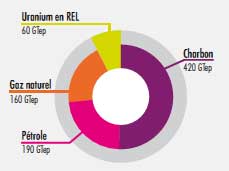
Total energetic contents of various sources of energy according to confirmed stocks
Purple: Coal / Pink: Oil / Orange: Natural Gas
Green: Uranium in Thermal Neutrons Reactors
This uranium-238 cannot be used in water-cooled reactors but could be used in FNRs, multiplying the energy content of uranium by a factor of more than 100. Thus the chart changes as follows:

Total energetic contents of various sources of energy according to confirmed stocks
Purple: Coal / Pink: Oil / Orange: Natural Gas
Green: Uranium in Fast Neutron Reactors
Global reserves of uranium-235 (the 1%-part) could be exhausted in less than a century if the rate of use follows the current trend. On the contrary, global reserves of coal are high enough to let coal power plants be operated for centuries, which could lead to an environmental disaster. However, for the nuclear reactions that take place in SFRs the exhaustion of uranium-238 used in these reactors is forecast as being after several millennia of electricity consumption! On top of that, due to uranium enrichment activities, several countries already own great amounts of depleted uranium, France included. This depleted uranium can be used to fuel SFRs, enabling the uranium supply to be secured.
As far as CO2 emissions are concerned, SFRs stand out as being millennium-sustainable, economically viable and a carbon-free source of energy.
France has a leading position in the nuclear energy industry due to its considerable experience and its high safety standards. Consequently, it has a duty to keep an eye on the required long-term strategy. If France does not get involved in the future of the nuclear industry, other countries will take the lead and their safety standards might become global standards, for better or for worse. General consensus dictates that we do everything possible to stop emitting greenhouse gases. That is why the future of nuclear energy must be developed now, by countries that have experience and credibility as regards progressively improving nuclear safety.
At the end of 2012 the first phase of the conceptual design was completed. The main safety features of the reactor were presented to the French Nuclear Safety Authority in a document sent in June 2012. Within three years, a major document, called the Safety Options File will be written. It will bring together all the strategic guidelines and rules governing reactor design. Thanks to this document, the basic design of the reactor will be carried out, leading to the writing of a Preliminary Safety Analysis Report, in 2019. First criticality could be achieved in 2025, so that the operation of ASTRID provides sufficient feedback of experience for commercial deployment from 2040.

ASTRID project schedule
This programme is not meant to optimise short-term profit. It is meant to prepare the future of energy sources. I strongly believe that centralized, intensive energy sources are needed, and that nuclear energy can continue to give our country a competitive advantage. In a few decades, thanks to the ASTRID project, economic, sustainable and carbon-free energy sources will be available that will prevent the release of greenhouse gases. This is the reason why I am involved in the ASTRID project.
An interview conducted by Fadhel Malouch and Charles Michel-Lévy of the SFEN YG
http://www.euronuclear.org/e-news/e-news-42/czech-slovak-ygn.htm

The Czech Young Generation (CYG) and the Young Generation section of the Slovak Nuclear Society (YG SNUS) have lot in common – not just their shared enthusiasm in support of nuclear energy, or the fact that their respective memberships are made up of nuclear experts less than 36 years old, but also because they also speak a similar language – one that Czechs and Slovaks shared for almost 70 years when they were both part of what was then Czechoslovakia. Hand in hand, both nations started building joint nuclear programmes when the former Czechoslovakia still existed and both parties significantly contributed to the commissioning of the first Czechoslovak nuclear power plant - A-1 in Jaslovske Bohunice and to subsequent units in Jaslovske Bohunice, Dukovany, Mochovce and Temelin. Despite (or maybe because of?) the break-up of Czechoslovakia, the ties between Slovaks and Czechs have remained very strong, both in terms of shared common history and a shared European bond. Nuclear experts from both sides of the border have cooperated closely for a long time (for instance with the organisation of the Bohemian-Moravian-Slovak Meeting of Reactor Physicists, which was reported here in an earlier edition of ENS NEWS). The YG sections in both countries followed suit and as a result both countries are now dealing with similar problems relating to nuclear energy, both on the technical side (with e.g. the operation of VVER reactors) and the political-social side (with regards to political approaches to nuclear power and to broad public support). Representatives of both the Czech and Slovak YG networks meet three times a year under the umbrella of the European Nuclear Society’s Young Generation Network (ENS YGN), where they promote the objectives of small central European pro-nuclear countries. Finally, members of both YG networks participate each year in the annual St. Nicholas meeting, where they present the results and achievements of their work.
Such a long and fruitful cooperation has led to a further strengthening of relations on a more informal, social basis. As a result, several Czechs and Slovaks took part in the first ever Czecho-Slovak YGN retreat in the Moravian village of Nemcicky, in February 2013. This was followed by the second Czecho-Slovak YGN retreat in the Slovakian city of Bratislava, in late September 2013.
Unlike at the St. Nicholas meeting, which was formal but basically still nuclear-related, or at ENS YGN meetings, which are both highly formal and strongly nuclear-related, Czecho-Slovak YGN retreats are meant to be truly informal social gatherings where participants relate to each other as young people and not just meet as nuclear just experts. These events help promote friendship as a solid basis for a constructive professional and more formal relationship.
The February meeting in Nemcicky was attended by 12 members of both YGNs, with Slovaks and Czechs almost equally represented. This informal meeting served as a free know-how and information exchange session, in particular with regards to nuclear decommissioning, an area where the Slovaks have extensive experiences as a result of the decommissioning of A-1 in Jaslovske Bohunice. Where else could you possibly learn about the further use of NPP recycled steel for the building of bridges and tunnels? Information was exchanged in the cosy setting of a Moravian wine cellar, where wine-tasting was the main social activity.
This initial meeting was followed by a kind invitation from the YG SNUS to visit the city of Bratislava. This time the YG SNUS hosted CYG members and Slovaks significantly outnumbered the Czechs. Both groups were equal, however, when it came to having fun and debating. The meeting was organized in much the same way as the February one in Nemcicky, with one main difference: instead of wine-tasting, beer-tasting was offered as the main social activity, in the oldest mini-brewery in Bratislava, called Richtar Jakub. Before that, a short tour of Bratislava was organized, with a visit to Bratislava castle and to the Bratislava Beerfest (beer festival), which just happened to be taking place on same day as the visit of the CYG. After that, a delightful time was had by all, enriched by presence of several beautiful Slovak female colleagues with a special interest in nuclear chemistry. They proved to be splendid companions. For the Czechs it was interesting to learn that Slovak companies are offered tax breaks if they support non-profit organizations; that is the case of the YG SNUS section which is, therefore, able to erect a “nuclear tent” at various cultural events thanks to support from Slovenske Elektrarne-ENEL.
Both these joint retreats showed that cooperation on an informal level is beneficial: not only to young people from different countries who get to meet each other, but also by laying down strong foundations for future professional cooperation. We would like to express our gratitude to both national nuclear societies, CNS and SNUS.
Ondrej Zlamal and Tomas Vytiska
Young Generation network of the Czech Nuclear Society
http://www.euronuclear.org/e-news/e-news-42/l-3.htm

MONTREAL, September 12, 2013 – L-3 MAPPS announced today that it has completed two major projects in support of South Africa’s Koeberg Power Station. These accomplishments include the completion of the refurbished plant models for the legacy Koeberg operator training simulator and putting into service a second full scope simulator at the site on August 1, 2013.
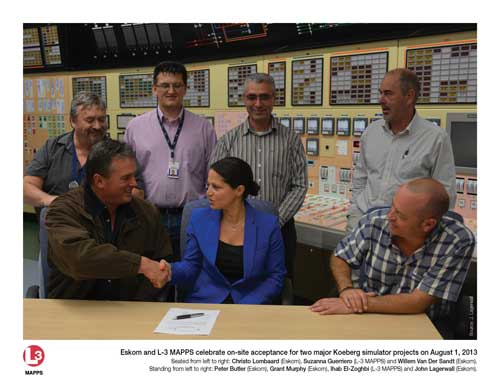
“The two projects in themselves were challenging, but it became clear that combining them would be beneficial to our overall project scheme,” said Christo Lombaard, operator training manager at Eskom’s Koeberg station. “Considering Eskom’s objectives, including timing the simulators to be ready concurrently with our new training center, we are pleased with the L-3 technology and with the cooperation between Eskom and L-3 MAPPS, which has resulted in high-quality, state-of-the-art simulators at Koeberg.”
“L-3 MAPPS is extremely pleased with our performance and we look forward to continuing our support of Eskom for years to come,” said Michael Chatlani, vice president of marketing & sales for L-3 MAPPS Power Systems and Simulation. “Following the putting into service of the Embalse full scope simulator in Argentina earlier this year, the Koeberg simulator deliveries in South Africa once again demonstrate that L-3 MAPPS is the world’s leading nuclear power plant simulation solution provider.”
The refurbishment of the legacy simulator was rolled out in two phases. Phase 1 included providing L-3’s Orchid® simulation platform, remodeling of the Balance of Plant (BOP) process loop, simulation of the new Alstom ALSPA CONTROSTEAM steam turbine controller, emulation of the core monitoring system display and provision of an interface to Westinghouse’s Ovation DCS. This deliverable enabled Koeberg to pretrain its operators for plant changes that followed in late 2010. Phase 2 consisted of upgrading the remaining plant models, including containment, emergency core cooling, electrical systems and common services in L-3’s Orchid Modeling Environment, and migrating the legacy control logic into the Orchid Modeling Environment through a translator.
The second full scope simulator involved replicating the plant’s main control room and emergency control facility driven by a compact modular input/output (I/O) system using WAGO-I/O-SYSTEM 750 hardware and L-3’s Orchid Input Output software. The new simulation platform and refurbished models were joined with the new second simulator’s hardware to facilitate validation and ultimate delivery to Eskom. As a follow-on effort, the legacy simulator’s I/O system will be replaced with the same compact, modular I/O system used on the second simulator.
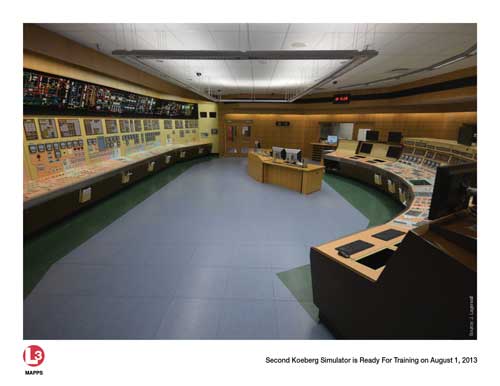
Eskom Holdings generates, transports and distributes approximately 95 percent of South Africa’s electricity and approximately 45% of the electricity used in Africa. Koeberg Power Station is the only nuclear power station on the African continent. It is situated at Duynefontein, 30 km northwest of Cape Town in South Africa on the Atlantic coast. Koeberg, with two pressurized water reactor units and the largest turbine generators in the southern hemisphere, produces 1,800 megawatts and ensures a reliable supply of electricity to the Western Cape, one of the fastest growing regions in South Africa. It has operated safely and efficiently for more than 25 years and has a further active life of 25 to 30 years.
L-3 MAPPS, a division of L-3 Marine & Power Systems, has over 30 years of experience in pioneering technological advances in the marine automation field and over 40 years of experience in delivering high-fidelity power plant simulation to leading utilities worldwide. In addition, the company has more than four decades of expertise in supplying plant computer systems for Canadian heavy water reactors. L-3 MAPPS also provides targeted controls and simulation solutions to the space sector. To learn more about L-3 MAPPS, please visit the company’s website at www.L-3com.com/MAPPS.
Comprising 25 operating companies, L-3 Marine & Power Systems (L-3 M&PS) is a worldwide leader in maritime automation and control, navigation, communications, dynamic positioning, and power distribution and conditioning for the U.S. Navy, allied foreign navies and commercial customers worldwide. L-3 M&PS also produces full-fidelity simulators for increased operator proficiency, resulting in safe operations for leading international utilities and ship operators. With over 85 locations in 19 countries, L-3 M&PS is a cohesive, global partner with extensive capabilities and a proven track record in delivering the highest level of technology, service and integration. To learn more about L-3 Marine & Power Systems, please visit the company’s website at www.L-3com.com/MPS.
Headquartered in New York City, L-3 employs approximately 51,000 people worldwide and is a prime contractor in C3ISR (Command, Control, Communications, Intelligence, Surveillance and Reconnaissance) systems, platform and logistics solutions, and national security solutions. L-3 is also a leading provider of a broad range of electronic systems used on military and commercial platforms. The company reported 2012 sales of $13.1 billion. To learn more about L-3, please visit the company’s website at www.L-3com.com.
Safe Harbor Statement Under the Private Securities Litigation Reform Act of 1995
Except for historical information contained herein, the matters set forth in this news release are forward-looking statements. Statements that are predictive in nature, that depend upon or refer to events or conditions or that include words such as “expects,” “anticipates,” “intends,” “plans,” “believes,” “estimates,” “will,” “could” and similar expressions are forward-looking statements. The forward-looking statements set forth above involve a number of risks and uncertainties that could cause actual results to differ materially from any such statement, including the risks and uncertainties discussed in the company’s Safe Harbor Compliance Statement for Forward-Looking Statements included in the company’s recent filings, including Forms 10-K and 10-Q, with the Securities and Exchange Commission. The forward-looking statements speak only as of the date made, and the company undertakes no obligation to update these forward-looking statements.
# # #
Orchid is a trademark of L-3 Communications MAPPS Inc. All other products are trademarks of their respective companies.
http://www.euronuclear.org/e-news/e-news-42/linn.htm


HT 1600 Vac Special
Linn High Therm, leading manufacturer of industrial and lab furnaces since 1969, presents:
High quality high temperature furnaces for universal heat treatment applications, graphitization, sintering, vacuum brazing e. g. in glass- and ceramic industry, nuclear industry, metal industry, R&D. Fiber- or graphite felt insulation. Vacuum tight furnace chamber with rotary vane pump, roots pump or turbo-molecular pump up to 5 x 10-4 mbar.
Useful volume: up to 52 l, Tmax: 2100 °C.
Protective gases: forming gas, nitrogen, argon.
Comprehensive Options allow an universal utilization: also for H2-operation, gas feeding- and burn-off device, safety package, vacuum pump systems, partial pressure control, condensate trap, dew point measuring device, multi-zone-control, heating elements: graphite, Kanthal-Super, molybdenum, gas re-cooling, circulation cooling unit and emergency water supply, viscometer.

http://www.euronuclear.org/e-news/e-news-42/kkw-goesgen.htm


Electrical power is the key energy source essential for the functioning of all developed societies. 60 % of Switzerland’s electricity is currently generated from hydropower and 40 % from nuclear.
As part of our succession planning in the nuclear fuel division of Gösgen Nuclear Power Plant, we are looking for a Specialist Engineer for Supply, Interim Storage and Logistics
http://www.euronuclear.org/e-news/e-news-42/enusa.htm

The reasons behind the progressive globalization of ENUSA’s operations can be found in the behaviour of its reference markets. As it became clear in the ‘80s that the Spanish market was not going to grow in the years ahead, the company decided to break into European markets with the support of its natural partners, Westinghouse and General Electric. As a result ENUSA is now exporting products and services to France, Belgium and Sweden and has supplied in the past to countries like Finland, Germany or Switzerland.
Now, given the current trend towards a reduction in European PWR and BWR fuel markets (see figure 1) ENUSA is looking abroad again to expand its business.
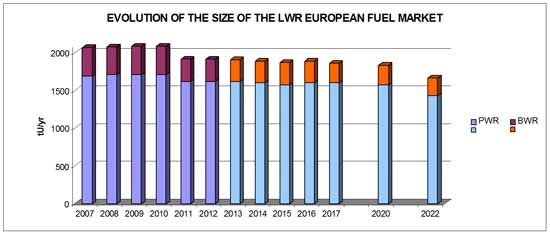
(Source: ENUSA)
From the maximum point that was reached in 2009-2010 the market is expected to decrease by approximately 20% due to the early shutdown of 23 reactors within the period 2007-2023 and to the fact that only two new connections to the grid will occur. The major factor is, obviously, the German phase-out. But it is not the only one. Spain, France and Belgium may see some of their reactors shutdown too. It has become clear that the Fukushima accident has altered the so-called nuclear renaissance in Europe, delaying it for several years.
Another factor which contributes to the internationalization strategy is the high level of competition within the European fuel market. Currently, there are five nuclear fuel factories (even more if we consider the TVEL facilities and the new Ukranian fuel factory) in operation, namely in the United Kingdom, Sweden, France, Germany and Spain. They are under the control of three different fuel vendors. Total installed capacity largely exceeds current fuel needs. This spare capacity in some cases is expected to be used for the supply of the first cores in other markets, although in other cases it is likely to result in overcapacity.
The new markets, being less mature than the European market, offer clear advantages such as a significant demand for new technology and growing market size. In addition, these markets offer positive projections for nuclear development over the coming decades, which is particularly clear in the cases of China and India. Overall, new capacity up to 2030, according to the most optimistic scenario, is expected to exceed 300 new units and more than 350 GWe (figure 2).
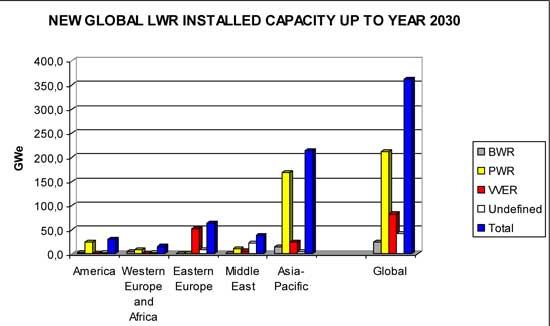
Figure 2: expected new global capacity in an optimistic scenario.
(Source: ENUSA)
As new capacity is added operators will require not only new fuel for their reactors but also all kinds of services associated with the operation of the reactors.
It is possible to make different segmentations according to criteria such as areas of geographical expansion, products and customers. A short review of each of these segmentations is presented below.
Figure 2 shows how new capacity is distributed worldwide. The weakness of the European market can be clearly identified, especially when compared to prevailing trends in regions such as Asia and the Pacific. Expected added capacity in this region alone may exceed 200 GWe up to the year 2030. India, China, Korea are building new units to satisfy their electricity-hungry cities and industrial infrastructure. There is a significant and fast-growing nuclear industry that can supply not only fuel but also different kinds of products and services. A majority of the companies supplying these products is state-owned. Localization is normally the criteria adopted by the national governments. There is still a long way to go before these countries reach the maturity of the North American or European markets.
Other regions are newcomers to nuclear energy. Middle East countries (Emirates, Saudi Arabia, Jordan, Turkey, etc.) are shifting from traditional oil-based electricity generation to cleaner, carbon dioxide-free production systems based on nuclear and renewable electricity. These countries lack the necessary infrastructure to build and operate new nuclear plants and, therefore, will need to import most of the supplies, at least for the first generation of reactors.
A third region of great interest is Eastern Europe (the Baltic countries, the Czech Republic, Slovakia, Bulgaria, Ukraine, Belarus, etc.). Two main factors are driving nuclear investment in this region: the countries’ dependence on Russian technology and their endeavour to search for alternative technology providers or vendors.
From an ENUSA perspective it is relevant to focus also on the South American market. Both Argentina and Brazil are building new reactors and there is a long-term investment plan in place for developing new nuclear capacity. These countries are developing their own industry, which eventually will cover the entire fuel cycle. However, some of their historic partners, in particular German companies, are no longer in the nuclear business. This clearly represents an opportunity for ENUSA.
In recent years ENUSA has evolved from being simply a fuel manufacturer into a more integrated fuel services provider. The fuel services it provides now include spent fuel, and on-site services such as additional inspection and repair capabilities have expanded. A new equipment design and manufacturing business is being developed.
Nuclear fuel is ENUSA’s reference product and it has established credentials in this field in the international markets. However, it is well known that the fuel market is a regional market where the fuel is produced close to the point of consumption. This clearly limits the potential expansion of businesses that only provide fuel. At the same time, this explains ENUSA’s success in the European market, where communications are well developed and the area is geographically small compared to other regions. Only reference vendors such as AREVA, Westinghouse or GNF are in a position to expand their fuel operations far from their headquarters.
There is, however, an exception to the limitations explained above and this relates to the development of new fuel assemblies for Generation III+ reactors that are about to start operating. Developing an alternative fuel design for the new reactors may offer advantages for operators as they will have access to more competition and potentially better prices.
The commercialization of fuel inspection equipment also offers many advantages. First, there is limited competition in this field and second, it is not usually subject to the political or technological barriers that nuclear materials (in some countries there is a “no import” policy when it comes to nuclear fuel) encounter. ENUSA is working very actively on developing its technology together with its partner TECNATOM. As a result of these efforts new fuel inspection equipment has been sold to China and Brazil and there is a big potential for new sales in other markets.
Finally, spent fuel services provide a third pillar to ENUSA’s business. The Spanish Interim Centralized Storage Facility (“ATC”) project and the maturity of the Spanish nuclear sector have brought this into the spotlight for the first time. ENUSA has decided to cooperate with ENRESA, ENSA and other Spanish companies to develop its own capabilities in this field, mainly linked to the dry storage of nuclear fuel. The Spanish experience can be valid for other countries that are less mature and that have not yet reached the point where spent fuel has become an urgent issue.
The addition of new products and services to ENUSA’s portfolio progressively broadens the range of potential customers. Traditionally, the main customer has always been the utility/operator of a nuclear power plant and since nuclear fuel is a key supply component for a power plant, the operator-fuel vendor relation will maintain its strategic importance both in traditional and new markets.
However, in new international markets one can now find vertically integrated conglomerates such as the Chinese CGN and CNNC, which not only operate their own reactors but also produce uranium concentrates, provide enrichment and conversion services, manufacture fuel assemblies, spent fuel solutions, etc. These companies may search for virtually any kind of product - at least in theory - because they usually operate according to a localization strategy or use in-house production.
Finally, the accumulated experience of ENUSA in the area of design and operation of advanced inspection equipment paves the way for a direct relationship with the fuel manufacturers. Together with its partners, in particular TECNATOM, ENUSA can provide technological solutions for fuel manufacturing plants by adapting the technology developed at the Juzbado plant to suit the specific requirements and needs of other fuel vendors.
The size, distance and complexity of international markets make it advisable to search for appropriate partners either in the country of origin or abroad.
ENUSA has already adopted both practices. As a founding member of the Spanish Nuclear Group for Cooperation (SNGC) it is one of the four Spanish companies that have join forces, or ‘associated’ to penetrate foreign markets. The initial target was China, but a similar approach is being applied to other regions of interest. The SNGC provides marketing and coordination services for its members and studies very carefully the most promising business opportunities.
The other approach that ENUSA is following is association with local companies in the export target market. This is being done with the assistance of a sales agent or representative who knows the specifics of the country and has direct contact with the local company. Once the company has been identified the usual approach is to sign a Memorandum of Understanding (MoU) to serve as a ‘contractual umbrella’ for the relationship. A second step may involve companies entering into specific sales agreements.
So far ENUSA has signed a number of MoU with several Asian and South American companies (see figure 3) and reached representation agreements in Brazil, Argentina and China.
At a sector level, the Spanish Nuclear Forum (ForoNuclear) continues providing valuable support for Spanish nuclear companies with the marketing of their products and services in the international marketplace. ForoNuclear usually coordinates the joint participation of Spanish companies in international conferences and exhibitions in places like China or India. The next step will be to present the capabilities of the national companies in the Middle East.
Another factor to be considered is the necessary institutional support. So far the Spanish Government has supported the Spanish nuclear industry via various different mechanisms, the most relevant one being the support given by ICEX. ICEX is an institution run under the auspices of the Ministry of Economy and Competitiveness that promotes Spanish companies in foreign markets. For certain types of business other parts of the government need to be involved, for example when a political agreement is required or when materials or technology need to be kept under control.
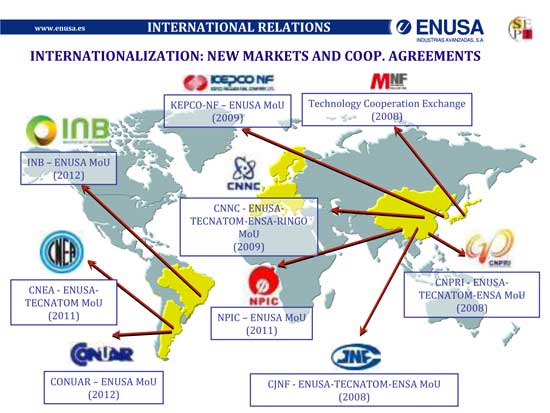
Figure 3: ENUSA international cooperation agreements
The ENUSA approach to international markets is a step-by-step one based on developing the maturity of the company. Each country and product can follow this process at its own pace, but conceptually it can be described as follows:
Stage 1: Direct export with commercial representation
This is the level at which ENUSA is currently operating. An external sales agent interacts with the local stakeholders to detect business opportunities. ENUSA then takes the lead in the commercial negotiations and, eventually, signs the contract. The products or services are provided from the country of origin, hence minimizing the risks involved. In ENUSA’s experience this approach works well for the sale of hardware like inspection equipment, but it is not so appropriate for more complex negotiations involving, for instance, the sale of nuclear fuel. ENUSA recently signed an agreement for the supply of inspection equipment to China following this process.
Stage 2: Establishment of a commercial subsidiary
This stage represents a second phase in the internationalization process. Once the consolidation of ENUSA in a foreign market becomes a reality, the logical decision is to create a subsidiary in the country in order to be closer to the final customer. This can be done with expatriate organisations or with national organisations in the target country. In the latter case there are obvious advantages like mastery of the local language or knowledge of local business culture.
The commercial subsidiary may avoid the need for having an external sales agent. Initially, both may cohabitate although the potential for conflicts of responsibility could result in the agent quitting its relationship with the company or, alternatively, becoming a member of the new subsidiary.
At this stage production will still be based in Spain. From an ENUSA perspective, given its actual size and potential business, this strategic option seems to be the most adequate way of accessing international markets.
Stage 3: Operations implemented in the foreign market
The final step in the internationalization process can be justified only for long-term or high added value projects that require a localization of production capability located in the foreign market. In the case of nuclear industry this is normally linked to the construction of new nuclear capacity as the markets usually require some level of localization. This kind of strategic project has multiple financial, technological or political implications and, therefore, is challenging for medium-sized companies like ENUSA. However, ENUSA shall continue searching for such opportunities worldwide by reaching strategic agreements with the main actors in the nuclear fuel business.
Internationalization implies a cultural change in the organization. It means dealing with a new reality and facing new risks and challenges. The organizational structure must also be adapted to serve the needs of a global company. A significant effort with regards to the development of technology, quality improvement and efficiency must be undertaken throughout the organization. ENUSA is working on these areas by implementing a more efficient organization, by boosting its continuous improvement programme and by reinforcing its investment in R&D, which currently ranges at between 6% and 10% of total annual sales.
Internationalization also means expanding the business, which in turn requires additional human, technological and financial resources. This can only be achieved with a clear strategic direction and strong institutional backing from the government. In the case of state-owned enterprises a third factor must also be considered - the support of SEPI Holding - ENUSA’s main shareholder - for internationalization initiatives. Fulfilling these conditions and embracing the new reality of globalization represent the best possible business option for ENUSA if it wants to pursue its international development and to reinforce its place in the global nuclear industry.
http://www.euronuclear.org/e-news/e-news-42/MYRRHA.htm

The Belgian Nuclear Research Centre (SCK•CEN) has awarded the contract for the technical design of an important component of MYRRHA. Following a selection procedure that took over two years another important step was made in the realization of this new multifunctional research infrastructure. MYRRHA is an innovative research reactor driven by a particle accelerator, and will be the first of its kind worldwide.
The contract that has been awarded, the Front End Engineering Design (FEED), consists of the technical design of all elements of the infrastructure, with the exception of the reactor itself and the particle accelerator. More specifically, this includes the design of the buildings, the cooling systems and the instrumentation and control of the reactor and the particle accelerator. “The design of the reactor itself has been carried out by our own team. But, of course, a reactor cannot work by itself. This FEED contract will cover everything that is not part of the SCK•CEN specializations”, clarified Hamid Aït Abderrahim, Director of the MYRRHA project.
Because of the technological challenges involved – there is no infrastructure in existence that is comparable to MYRRHA – an initial selection of candidates was made on the basis of proven technological competence. Following the global assessment of the remaining candidates, the contract was awarded to an international consortium consisting of the French company Areva TA, the Italian company Ansaldo Nucleare and Empresarios Agrupados from Spain. The Belgian company Grontmij will execute part of the tender as a subcontractor of Areva TA. “The selection was very strict, and we attached the greatest value to proven quality and credentials. We are fully confident that this consortium will bring the work to a successful conclusion”, confirmed Hamid Aït Abderrahim.
The contract represents a value of €24 million. As soon as this study and design contract has been completed this special project will be ready for construction, and the first contracts for the realisation of the various components of MYRRHA can be concluded.
The MYRRHA research reactor will contribute to the development of transmutation as a technique for recycling and processing highly radioactive waste. MYRRHA is scheduled to enter full operation in 2024-2025.
MYRRHA is a flexible research reactor driven by a particle accelerator, which will open the way to many promising technologies and applications. It provides an important contribution to solving the nuclear waste issue. This is done on the one hand by the development of transmutation as a technique for recycling and processing highly radioactive waste, while on the other hand it will also contribute to the more efficient use of the natural reserves of uranium, thereby ensuring that less nuclear waste is created. MYRRHA will also take over the role of the BR2 reactor for the production and development of radioisotopes that detect and combat cancers. Furthermore, it will contribute to the low-CO2 economy thanks to the major role that it plays in the development of fourth-generation nuclear reactors and nuclear fusion reactors. A study of the Strategic Projects Organisation Kempen (SPK) showed that the realisation of MYRRHA will generate up to 2,000 permanent jobs, both direct and indirect ones.

AREVA
AREVA supplies advanced technological solutions for low-carbon power generation. Its expertise and unwavering insistence on safety, security, transparency and ethics are setting the standard, and its responsible development is anchored in a process of continuous improvement.
Ranked first in the global nuclear power industry, AREVA’s unique integrated offer to utilities covers every stage of the fuel cycle, from nuclear reactor design and construction to operating services. The group is also expanding its renewable energies (wind, bioenergy, solar, energy storage) activities in order to become a European leader in this sector too.
With these two major offers in its portfolio AREVA and its 46,000 employees are helping to supply ever safer, cleaner and more economical energy to the greatest possible number of people.
Ansaldo Nucleare has significant experience with CANDU plants in Europe and with AP1000 plants too. The company plays a relevant role in the definition of safety standards and in the development of passive safety systems for Gen-IV reactors, specifically Lead-cooled Fast Reactors. Ansaldo had been involved since 1998 in Accelerator Driven Systems aiming at the transmutation of nuclear waste when Prof. Rubbia first presented his proposal at CERN. Since 2002, the cooperation with SCK-CEN has been strengthened within the framework of existing European research programmes, from the initial concepts to the recent FASTEF/MYRRHA, with a centralised multi-disciplinary team based in Mol.
Empresarios Agrupados is a leading international architect-engineering company. Active in nuclear and conventional power generation projects from new built power plants to operational services and decommissioning, Empresarios is also a major player in EU TACIS, PHARE & EURATOM projects for the development of GEN-IV technologies, as well as in the international ITER fusion reactor project. Its 200 years old collaboration with SCK-CEN includes work on the preparation of the EU’s SET (Strategic Energy Technology) Plan and projects such as ADS, EUROTRANS and CDT, all of which are aimed at enhancing the contribution that MYRRHA will make to new generation reactors and supporting its technology.
Grontmij is a major player in Belgium in the industrial installations and buildings sector. It is also present internationally in sectors such as the decommissioning of nuclear power plants in the Netherlands and the provision of services to the Swedish nuclear industry. It has been partly involved in the study of the Lead-Bismuth process design by SCK-CEN. As it is very familiar with Belgian local rules and regulations, Grontmij’s participation in the consortium is a real asset for the MYRRHA project.
http://www.euronuclear.org/e-news/e-news-42/trasnusafe.htm
27 - 28 November 2013 in Manchester, UK
http://www.euronuclear.org/e-news/e-news-42/ecvet.htm

Abstract
The European Credit System for Vocational Training (ECVET) recommendation by the European Parliament and the Council, 2009, invites Member States to start progressive ECVET implementation from 2012 onwards with a possible evaluation foreseen in 2014.
As part of its support for the introduction of ECVET in the nuclear energy sector, the Institute for Energy and Transport (DG JRC, EC), through the action CAPTURE, developed three tools for action: the European Human Resources Observatory for the Nuclear Energy Sector (EHRO-N), a series of workshops on Nuclear Job Taxonomy development and a series of ECVET Seminars customized for the Nuclear Energy sector.
The following abstract for ENS NEWS emphasises the specific support actions that have been initiated by the IET, which is part of the EC’s DG JRC, through the intiative CAPTURE, in order to implement the European Credit System for Vocational Training (ECVET) in the nuclear energy sector, with a special focus given to the 2nd ECVET Seminar for the Nuclear Energy Sector (Budapest, 7-9 October 2013).
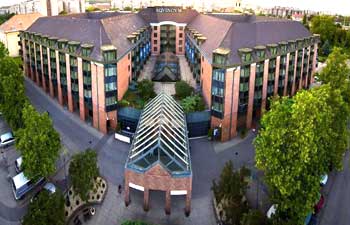
Recently, the IET at JRC-Petten organised the Second ECVET Seminar for the Nuclear Energy Sector, in collaboration with the ECVET-Team of DG EAC and DG RTD. The seminar was held from 7 - 9 October 2013, in Budapest, at the Aquincum Hotel (Fig. 1). The event’s main objective was to offer to the nuclear VET providers the opportunity to acquire the knowledge needed for implementing the ECVET system. The seminar was attended by participants selected according to their nuclear background, as well as to their interest in implementing ECVET in their respective institutions. In addition, the second seminar had a strong practical profile (Fig. 2), answering specific problems raised by the participants in the first seminar, such as: defining nuclear qualifications, designing units of Learning Outcomes (LO) and LO itself.
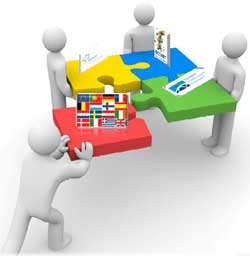
The seminar was organised according to four sessions: VET in the European Context, Designing LO and Units, The question of transfer and From Qualifications to Training Program for the Nuclear Sector.
The main topics addressed during the Second ECVET Seminar were as follows:
The role of the IET-JRC in ECVET implementation, presented by Alicia Lacal-Molina
ECVET in the European Context, presented by Rob van Wezel
From Qualifications to Training Program for the Nuclear Sector, presented by Thierry Lefeuvre
Case studies: Designing nuclear qualifications, LO and Units of LO, presented by Mihail Ceclan
After three days of debates and case studies, the participants evaluated the seminar as ‘good to excellent’ in terms of organization and ‘useful to important’ in terms of ECVET knowledge acquired.
Readers can get all ECVET information regarding the Institute for Energy and Transport of JRC-Petten activities from the ECVET section of ehron.jrc.ec.europa.eu.
By Mihail CECLAN, European Commission’s Joint Research Centre, Institute for Energy and Transport (IET)
http://www.euronuclear.org/e-news/e-news-42/ecvet-2.htm

By Alicia Lacal Molina and César Chenel Ramos
The European Human Resources Observatory – Nuclear (EHRO-N), by means of its operating agency, the Institute for Energy and Transport (IET) of the Joint Research Centre of the European Commission (EC), initiated in 2011 the preparation of a so-called ‘Nuclear Job Taxonomy.’ This answered the request received from DG RTD and DG EAC to promote the implementation of the European Credit System for Vocational Education and Training (ECVET)1 in the nuclear sector.
This Nuclear Job Taxonomy aims to create an inventory of the jobs typically present in a nuclear power plant (NPP), encompassing its three life-cycle phases and providing a detailed account of the requirements needed to perform each of those jobs. Taking an approach that is in accordance with the ECVET principles these requirements are expressed solely in terms of competence.
A catalogue of competences built up over the development of the taxonomy has reached the stage where it can be considered an additional and separate outcome of the project.
Once completed the taxonomy shall offer a number of potential benefits, key among which will be the creation of a reference document for the description of qualifications in terms of learning outcomes (LOs).
As a reference document for the description of qualification of an LO the taxonomy can guarantee the harmonization of ECVET's implementation in the nuclear field, favouring the increase of international mobility, saving costs and effort and tackling the actual human resources gap in this field.
Lacking the necessary in-house workforce and know-how and also driven by the need to provide a trans-European dimension to the project, the IET launched in October 2011 a series of technical workshops targeting experts in the area of nuclear human resources, training and education. A part of these meetings has been devoted to the promotion of the ECVET initiative and the specifications relevant for the task. As awareness grew, the focus gradually shifted towards technical work, which consisted of the preparation of job lists and job profiles. At the same time the design concept of the taxonomy has been revised and progressively fine-tuned.
As the project has gained visibility, its impact has grown, a fact that is reflected in the increased participation in the workshops.
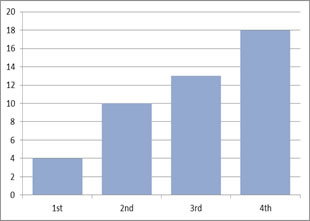
Figure 1: number of participants in the ECVET Workshops
It is worth mentioning the high rate of continuity: around two thirds of the contributors to each of the first three meetings attended the next one. This gives a positive indication of the level of interest in the project, which has generated a small but committed group of practitioners.
Besides the total figures, the diverse range of contributors' country and the type of organisation were a necessary precondition for ensuring an adequate outcome on an EU-wide level. As shown in the figures below, this diversity has been reasonably well achieved.
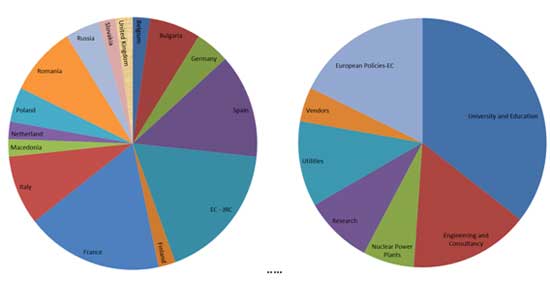
Figure 2: Participations per type of organisation - - - Figure 3: Participations per country
After several revisions the work methodology for the preparation of the job profiles has been finalised according to a three-step workflow consisting of a draft preparation, an individual review and a group review of every profile. Although the job lists are subject to continuous revision and taking into account the fact that there are currently 155 positions covered, this means that there are 465 tasks in total. Around fifty per cent of them have been completed. Around one out of nine positions has at least reached the first draft stage.
Simultaneously to the preparation of the profiles, the concept has been discussed and revised in every workshop, leading to successive modifications of the profile template. The present model aims for a very concise formulation of the job requirements, which are individually marked with the European Qualifications Framework (EQF)2 descriptors. As it is competence-focused the reference to associated academic levels has recently been removed. According to the conclusions of the last workshop, a more systematic terminology and categorisation shall be implemented to define the job titles.
The Competence Catalogue contains nearly 650 entries. The IET is seeking an expert partner to carry out the necessary screening, structuring and expansion of the Competence Catalogue.
The finalisation of the job profiles still requires an important investment of resources. The remaining tasks to be carried out are to a large extent reliant on group reviews, which are significantly time-consuming.
Regarding the sectors involved in the project, so far the presence of the scientific and education sectors prevails: universities, training providers and research centres. It would be desirable to increase the presence of the industry, particularly NPP operators that will be the final users of the human resources trained under the ECVET system. Furthermore, the project has been partly hindered by a deficit of input for NPP design and construction activities, which caused the slower advance of the new build phase.
Also, a broadening of the scope of the taxonomy could be undertaken sometime in the near future to incorporate nuclear activities related to fission generation that are outside the NPP, such as regulatory bodies and research institutes.
Finally, after the completion of the taxonomy it will be necessary to submit the results for consensus among all stakeholders that are part of the nuclear field including: nuclear authorities (TSO's), educational institutions (universities and VET providers) and industry (particularly NPP operators).
The resolution of these potential challenges could benefit the implementation of ECVET in the nuclear field and, thereby, help to close the human resources gap that currently persists in Europe's nuclear industry.
Read more at ehron.jrc.ec.europa.eu/job-taxonomy
1ECVET Recommendation:
eur-lex.europa.eu/LexUriServ/LexUriServ.do?uri=OJ:C:2009:155:0011:0018:EN:PDF
2 EQF Recommendation:
eur-lex.europa.eu/LexUriServ/LexUriServ.do?uri=OJ:C:2008:111:0001:0007:EN:PDF
http://www.euronuclear.org/e-news/e-news-42/other-conferences.htm

18 - 23 May 2014
Aix-en-Provence
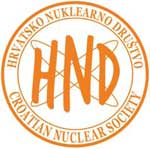
1- 4 June 2014
Zadar, Croatia
more

2nd International Symposium on Cement-based Materials for Nuclear Wastes
3 - 6 June 2014
Avignon, Popes’ Palace, France
more
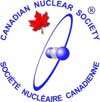
24 - 28 August 2014
Vancouver, Canada
more

14 - 14 September 2014
Sendai, Japan
more

Contribution of Materials Investigations and Operating Experience to LWRs’ Safety, Performance and Reliability
14 - 18 September 2014
Avignon, Popes’ Palace, France
more
![]()
28 September - 3 October 2014
Kyoto, Japan
more
![]()
26 - 31 October 2014
Sapporo, Japan
more
http://www.euronuclear.org/e-news/e-news-42/Member-Societies.htm

| Austrian
Nuclear Society http://www.oektg.at |
Belgian
Nuclear Society http://www.bnsorg.be |
| Bulgarian
Nuclear Society http://www.bgns.bg |
Croatian
Nuclear Society http://www.nuklearno-drustvo.hr |
| Czech Nuclear Society http://www.csvts.cz/cns |
Finnish
Nuclear Society http://www.ats-fns.fi |
| French
Nuclear Energy Society (SFEN) http://www.sfen.org |
German
Nuclear Society (KTG) http://www.ktg.org |
| Hungarian
Nuclear Society http://www.nuklearis.hu |
The
Israel Nuclear Society E-mail: meins@tx.technion.ac.il |
| Italian
Nuclear Association http://www.assonucleare.it E-mailt: info@assonucleare.it |
Lithuanian
Nuclear Energy Association http://www.lbea.lt |
| Netherlands Nuclear Society http://www.kerntechniek.nl |
The Nuclear Institute http://www.nuclearinst.com |
| Nuclear
Society of Russia E-mail: agagarin@kiae.ru membership on hold |
Nuclear
Society of Serbia http://nss.vin.bg.ac.yu/ |
| Nuclear
Society of Slovenia http://www.djs.si/ |
Polish
Nuclear Society http://www.nuclear.pl |
| Romanian
Nuclear Energy Association (AREN) http://www.aren.ro |
Slovak
Nuclear Society http://www.snus.sk |
| Spanish
Nuclear Society http://www.sne.es |
Swedish
Nuclear Society http://www.karnteknik.se |
| Swiss
Nuclear Society http://www.sns-online.ch |
http://www.euronuclear.org/e-news/e-news-42/Corporate-Members.htm
Links to ENS Corporate Members |
| AF-Colenco Ltd., Nuclear Technology
Department link |
Alpiq Ltd link |
| Alpiq Suisse Ltd. link |
Andritz AG link |
| Ansaldo Nucleare S.p.A link |
AREVA NP GmbH E-mail: unternehmenskommunikation @areva.com link |
| Atomic Energy Council (AEC) link |
Atomic Energy of Canada Limited (AECL) link |
| Atomexpo LLC link |
Atomtex SPE link |
| Axpo AG link |
BKW FMB Energie AG link |
| Chilean Nuclear Energy Commisssion link |
Electrabel, Generation Department link |
| NV Elektriciteits-Produktiemaatschappij
Zuid-Nederland EPZ link |
Electricité de France (EDF), Communication Division link |
| Euro Nuclear Services BV E-mail: ens@unitech.ws link |
E.O.N Kernkraft GmbH link |
| ENUSA Industrias Avanzadas SA link |
EXCEL Services Corporation link |
| GE Nuclear Energy peter.wells@gene.ge.com |
IEA of Japan Co. Ltd link |
| Kernkraftwerk Gösgen-Däniken
AG link |
Kernkraftwerk Leibstadt AG (KKL), link |
| L-3 Communications MAPPS Inc. link |
Linn High Therm GmbH link |
| Elektroinstitut Milan Vidmar E-mail: mladen.iglic@eimv.si |
NRG Arnhem link |
| NRG Petten link |
NUKEM Technologies GmbH link |
| ONET TECHNOLOGIES link |
MVM Paks Nuclear Power Plant Ltd link |
| Paul Scherrer Institute link |
Polimaster Ltd link |
| Saphymo GmbH link and link |
Siempelkamp Nukleartechnik
GmbH E-mail: wolfgang.steinwarz@ siempelkamp.com link |
| SKB (Swedish Nuclear Fuel and Waste Management
Company) E-mail: info@skb.se link |
Studiecentrum voor Kernenergie, Centre d’Etude
de l’Energie Nucléaire SCK/CEN link |
| Synatom E-mail: mailmaster@synatom.com |
Taiwan Power Company (Taipower) link |
| Taiwan Atomic Energy Council (AEC) link |
Teollisuuden Voima Oyj / Industrial Power
Company Ltd (TVO) link |
| Tractebel Engineering S. A. link |
UNESA E-mail: nuclear@unesa.es link |
| Urenco Limited link |
Vattenfall AB link |
| VNS – Vinçotte Nuclear Safety link |
VTT Nuclear link |
| Westinghouse Electric Company link |
World Association of Nuclear Operators
(WANO), link |
http://www.euronuclear.org/e-news/e-news-42/editorial.htm

Editorial Staff:
Mark O’Donovan, Editor-in-Chief
Contributors to this Issue:
Bernard Bonin (ENS HSC)
Richard Borbély (SNUS Young Generation)
Mihail Ceclan (European Commission)
César Chenel Ramos (European Commission)
Jana Dymáčková (Research Centre Rez, plc)
Kirsten Epskamp (ENS)
Petr Kovařík (Research Centre Rez, plc)
Charles Michel-Lévy (SFEN Young Generation)
Fadhel Malouch (SFEN Young Generation)
Alicia Lacal Molina (European Commission)
Dubravko Pevec (Croatian Nuclear Society)
Juhani Santaholma (former Chairman of the ENS Information Committee)
Marko Streit (ENS)
Tomas Vytiska (Czech YGN)
Ondrej Zlamal (Czech YGN)
Realisation:
Marion Brünglinghaus
Avenue des Arts 56, BE-1000 Brussels
Phone +32 2 505 30 50 - Fax: +32 2 502 39 02
E-mail: info@euronuclear.org - http://www.euronuclear.org
The ENS News is a quarterly publication, in electronic
form only.
Copyright notice ©2013 European Nuclear Society.
Reproduction is authorised provided that the ENS News is acknowledged as the
source – except where otherwise stated.
![]()
© European Nuclear Society, 2013